Chapter 4. Phone Calls & FaceTime
With each successive iPhone model, Apple improves the iPhone’s antennas, circuitry, speakers, microphones, and software, improving its calling ability year after year. Meanwhile, features like Siri, autoreply, and Do Not Disturb have turned Apple’s phone from an also-ran into one of the most useful gadgets ever to hop onto a cellular network.
Dialing from the Phone App
Suppose you’re in luck. Suppose the bars at the top of the screen tell you that you’ve got cellular reception. You’re ready to start a conversation. To make a phone call, open the Phone app. It’s usually at the bottom of the Home screen. (The tiny circled number, like ![]() , tells you how many missed calls and voicemail messages you have.)
, tells you how many missed calls and voicemail messages you have.)
TIP
Using Siri is often faster. You get good results saying things like, “Call Casey Robin’s cell” or “Dial 866-2331.” Truth is, you don’t even need the verb. If you utter only a phone number to Siri, she’ll figure out what to do.
Now you’ve arrived in the Phone app. The icons at the bottom represent your voicemail (“Visual Voicemail”) and the four ways of dialing from here:
Favorites. Here’s the iPhone’s version of speed dial: It lists up to 50 people you think you call most frequently. Tap a name to make the call. (Details on building and editing this list begin on the next page.)
Recents. Every call you’ve recently made, answered, missed, or even just dialed appears in this list. Missed callers’ names appear in red lettering, which makes it easy to spot them—and to call them back.
Tap a name or a number to dial. Or tap the
 to view the details of a call—when, where, how long—and, if you like, to add this number to your Contacts list.
to view the details of a call—when, where, how long—and, if you like, to add this number to your Contacts list.Contacts. This program also has an icon of its own on the Home screen; you don’t have to drill down to it through the Phone button. It’s your phone book; tap somebody’s name or number to dial it.
Keypad. This dialing pad’s big, fat buttons are easy to hit even with big, fat fingers. Punch in a number and then tap
 to place the call.
to place the call.
Once you’ve dialed, no matter which method you used, either hold the iPhone up to your head, put in the earbuds or AirPods, turn on the speakerphone, or put on your Bluetooth earpiece—and start talking!
This, however, is only the Quick Start Guide. Here’s a more detailed look at each of the Phone app modules.
The Favorites List
You may not wind up dialing much from Contacts. That’s the master list, all right, but it’s too unwieldy when you just want to call your spouse, your boss, or your lawyer. Dialing by voice (Chapter 5) is almost always faster. But when silence is golden, at the very least use the Favorites list—a short, easy-to-scan list of the people you call most often (facing page, left).
Actually, calling is only the beginning. A favorite can be any kind of “address”: for an email, text message, video call, even an internet voice call in an app like WhatsApp, Skype, or Cisco Spark. In other words, you can set things up so one tap on a favorite opens an outgoing text to your beloved, and a different tap triggers a Skype call to your boss.
TIP
Once you’ve set up these favorites, you can add them to the Today screen (“Making DNDWD Mandatory”), so that placing one of these calls or text communications is only a swipe and a tap away.
You can add names to this list in any of three ways:
From the Favorites list itself. Tap
 to view your Contacts list. Tap the person you want. If there’s more than one phone number or email address on the info screen, then tap the one you want to add to Favorites.
to view your Contacts list. Tap the person you want. If there’s more than one phone number or email address on the info screen, then tap the one you want to add to Favorites.TIP
Each favorite doesn’t represent a person; it represents a number or address. So if your best friend Chris has both a home number and a cell number, then add two items to the Favorites list. Gray lettering in the list lets you know whether each number or address is mobile, home, Skype, Messages, FaceTime, or whatever.

From the Contacts list. Tap a name to open the info screen, where you’ll find a button called Add to Favorites. It opens the Add to Favorites panel shown above at right. For each of its four communication methods—Message, Call, Video, Mail—you get a pop-up menu that lists your available apps for performing that sort of human contact.
Tap the one you want to add to Favorites.
From the Recents list. Tap
 next to any name or number in the Recents list. If it’s somebody who’s already in your Contacts list, you arrive at the Call Details screen, where one tap on Add to Favorites does what it says.
next to any name or number in the Recents list. If it’s somebody who’s already in your Contacts list, you arrive at the Call Details screen, where one tap on Add to Favorites does what it says.If it’s somebody who’s not in Contacts yet, you’ll have to put her there first. Tap Create New Contact, and then proceed as described in “Adding to the Contacts List”. After you hit Save, you return to the Call Details screen so you can tap Add to Favorites.
TIP
To help you remember that a certain phone number or email address is already in your Favorites list, a gray star appears next to it in certain spots, like the Call Details screen and the Contact Info screen.
The Favorites list holds 50 numbers. Once you’ve added 50, the Add to Favorites and ![]() buttons disappear.
buttons disappear.
NOTE
The face of each favorite peeks out of a round frame next to the name. If your Contacts card for that person doesn’t have a photo—or Animoji!—the circle shows the person’s initials instead.
Reordering Favorites
Tapping that Edit button at the top of the Favorites list offers another handy feature, too: It lets you drag names up and down, so the most important people appear at the top of the list. Just use the grip strip (![]() ) as a handle to move entire names up or down the list.
) as a handle to move entire names up or down the list.
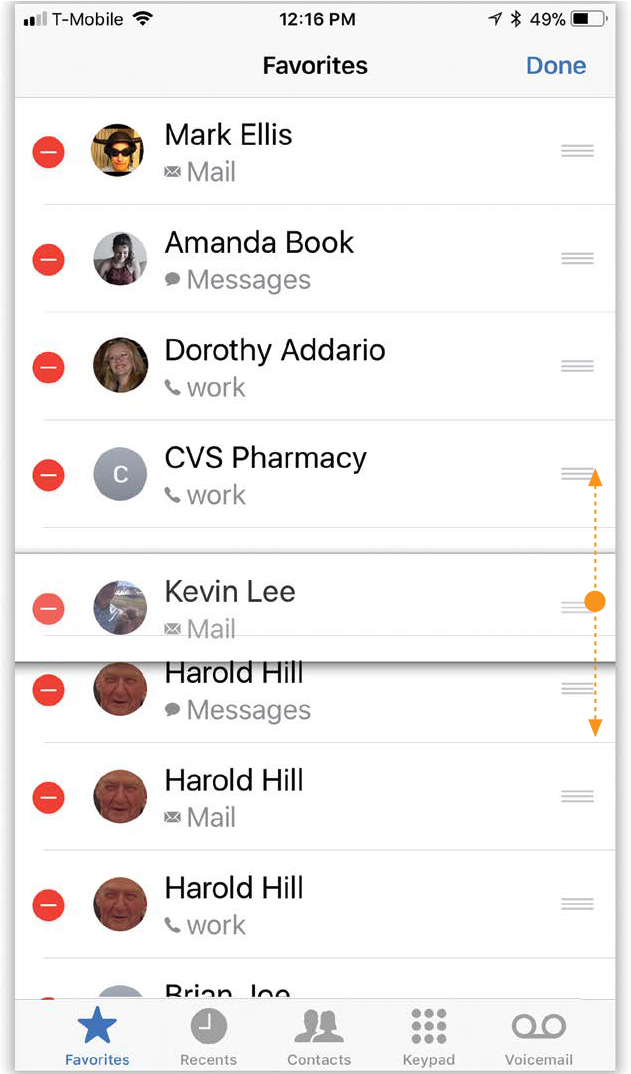
Deleting from Favorites
To delete somebody from your Favorites—the morning after a nasty political argument, for example—use the iPhone’s standard shortcut: Swipe leftward across the undesired name. Tap Delete.
(If you’re paid by the hour, you can use the slow method, too. Tap Edit. Now tap the ![]() button next to the unwanted entry and tap Delete to confirm.)
button next to the unwanted entry and tap Delete to confirm.)
The Recents List
Like any self-respecting cellphone, the iPhone maintains a list of everybody you’ve called or who’s called you recently. The idea, of course, is to provide you with a quick way to call someone you’ve been talking to lately.
To see the list, tap Recents at the bottom of the Phone app. You see a list of the last 75 calls you’ve received or placed, along with each person’s name or number (depending on whether that name is in Contacts or not), city of the caller’s home area code (for callers not in your Contacts), time or date of the call, and what kind of call it was—mobile, home, work, FaceTime, FaceTime Audio, Skype, or whatever.

Here’s what you need to know about the Recents list:
Calls you missed (or sent to voicemail) appear in red type. If you tap Missed at the top of the screen, you see only your missed calls. The color-coding and separate listings are designed to make it easy for you to return calls you missed, or to try again to reach someone who didn’t answer when you called.
A tiny
 or
or  icon lets you know which calls you made (to differentiate them from calls you received).
icon lets you know which calls you made (to differentiate them from calls you received).To call someone back—regardless of whether you answered or dialed the call—tap that name or number in the list.
“Maybe: Casey Robin” appears when the iPhone guesses at the caller’s name—by looking for a matching phone number in the signature portion of your received email! For example, if Casey Robin has called you from 213-292-3344, and there’s also an email from Casey that includes a phone number as part of the signature, the Recents list says: Maybe: Casey Robin. Clever!
Tap
 next to any call to open the info screen. At the top of the screen, you can see a list of recent calls, and whether each was incoming, outgoing, missed, or canceled (in which you chickened out and hung up before your callee answered).
next to any call to open the info screen. At the top of the screen, you can see a list of recent calls, and whether each was incoming, outgoing, missed, or canceled (in which you chickened out and hung up before your callee answered).What else you see here depends on whether the other person is in your Contacts list.
If so, the info screen displays the person’s whole information card (below, left). A little table displays all the incoming and outgoing calls to or from this person that day. A small gray star denotes a phone number that’s also in your Favorites list, and a Recent label indicates which number that recent call came from (or went to).
If the call isn’t from someone in your Contacts, you get to see a handy notation at the top of the info screen: the city and state where the calling phone is registered (below, right).
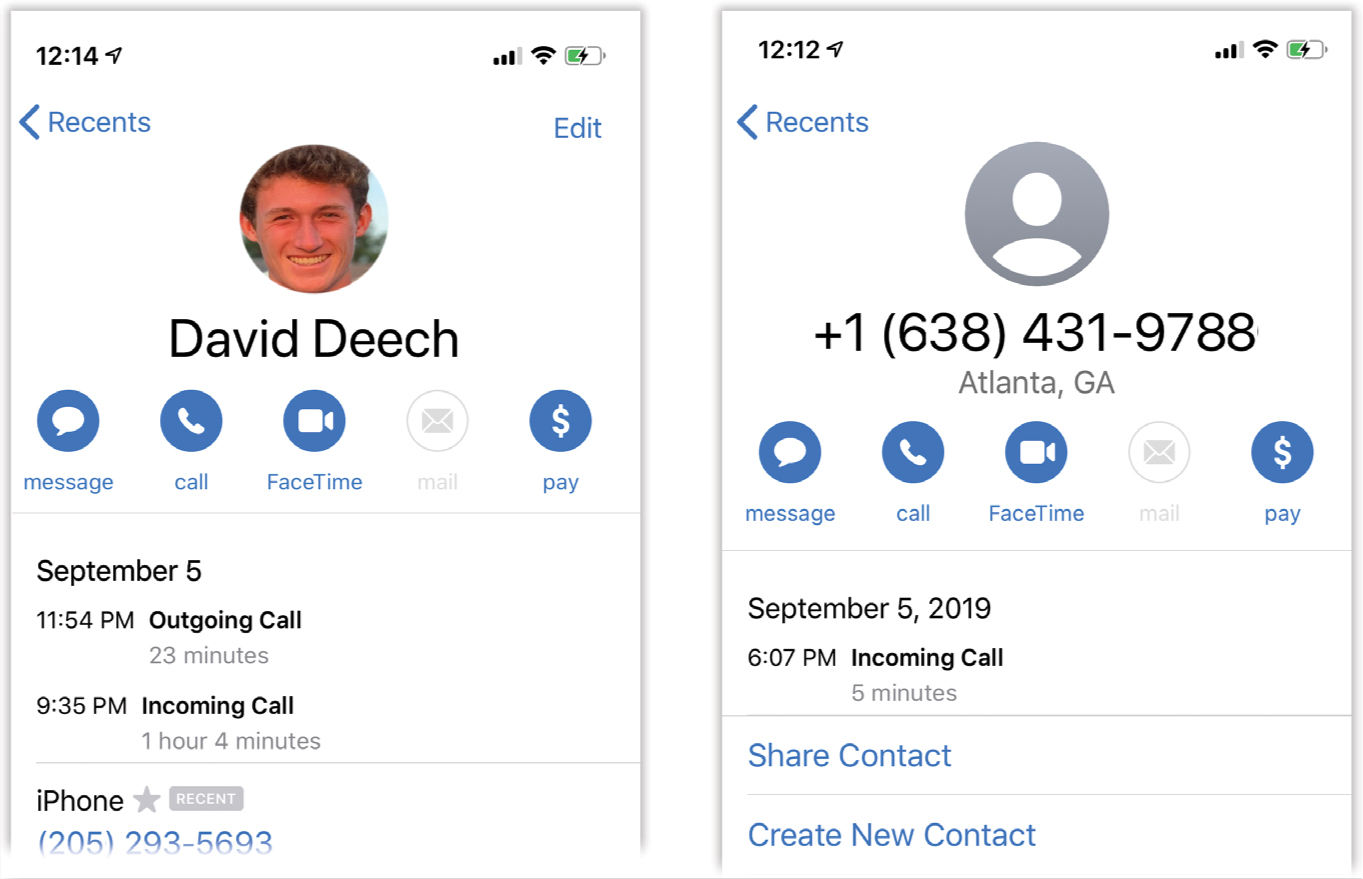
To save you scrolling, the Recents list thoughtfully combines consecutive calls to or from the same person. If some obsessed ex-lover has been calling you every ten minutes for four hours, you’ll see “Chris Meyerson (24)” in the Recents list. (Tap
 to see the exact times of the calls.)
to see the exact times of the calls.)You can erase one call from this list exactly the same way you’d delete a favorite: Swipe leftward across the undesired name. Tap the Delete button that appears. (Once again, there’s also a long way: Tap Edit, tap
 next to the unwanted entry, and then tap Delete.)
next to the unwanted entry, and then tap Delete.)You can also erase the entire list, thus preventing a co-worker or significant other from discovering your illicit activities: Tap Edit, and then tap Clear at the top of the screen. You’re asked to confirm your decision.
Contacts
The Phone app may offer four ways to dial—Favorites, Recents, Contacts, and Keypad—but the Contacts list is the source from which all other lists spring. That’s probably why it’s listed several times: once with its own icon on the Home screen, again at the bottom of the Phone app, and also in the FaceTime and Messages apps (when you tap the ![]() ).
).
Contacts is your address book—your master phone book.
NOTE
Your iPhone’s own phone number appears at the top of the Contacts list. That’s a much better place for it than deep at the end of a menu labyrinth, where it is on most phones.
If your social circle is longer than one screenful, you can navigate this list in any of three ways:
First, you can savor the distinct pleasure of flicking through it.
Second, if you’re in a hurry to get to the V’s, use the A-to-Z index down the right edge of the screen. Just tap the first letter of the last name you’re looking for. Or slide your finger up or down the index. The list scrolls with it.
Third, you can use the search box at the very top of the list, above the A’s.
Tap to make the keyboard appear. As you type, Contacts pares down the list, hiding everyone whose first, last, or company name doesn’t match what you’ve typed so far. It’s a really fast way to pluck one name out of a haystack.
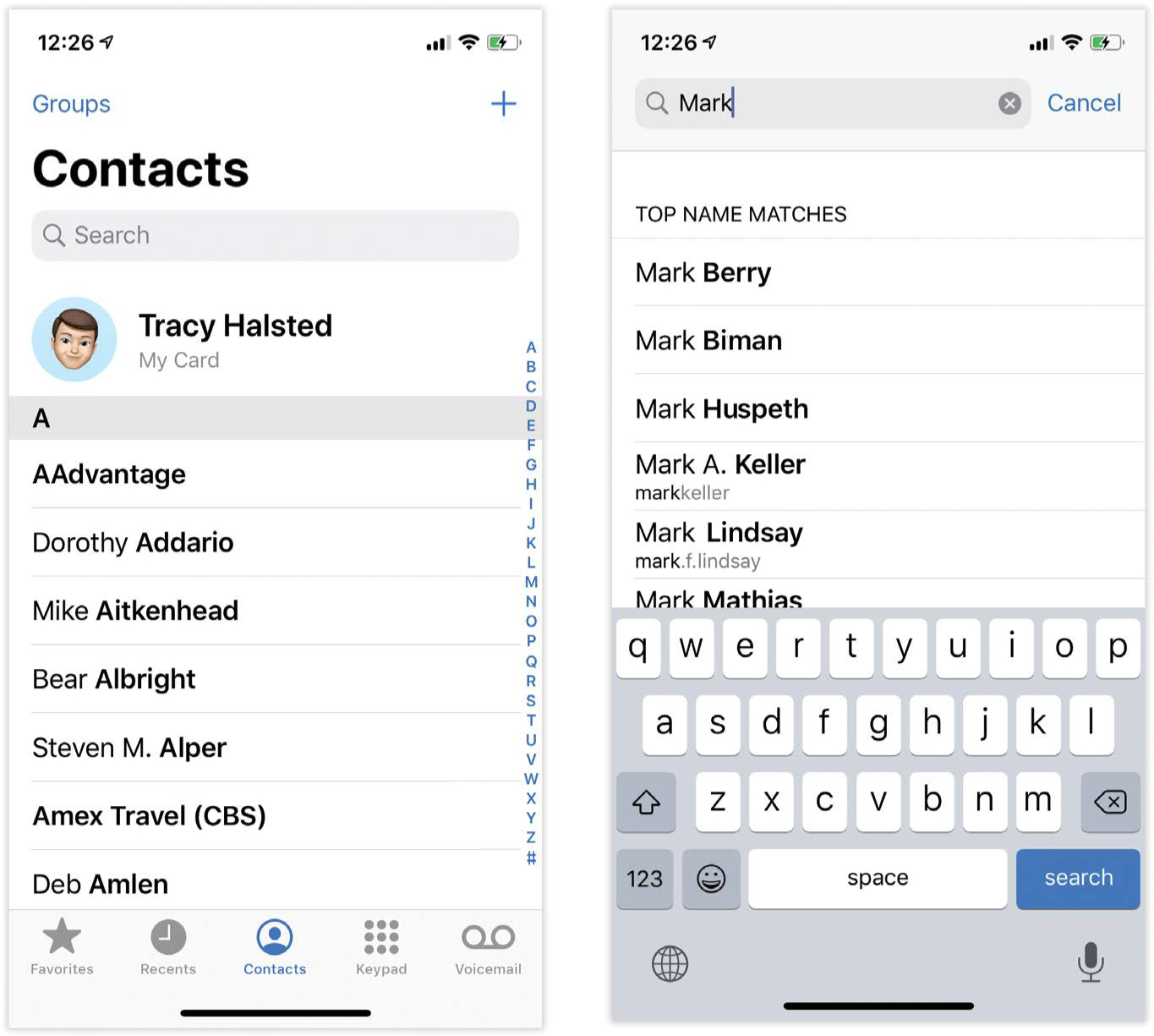
(You can clear the search box by tapping the
 at its right end or restore the full list by tapping Cancel.)
at its right end or restore the full list by tapping Cancel.)
In any case, when you see the name you want, tap it to open its information card. Tap the number you want to dial.
Groups
Many computer address book programs, including the Mac’s Contacts app, let you place your contacts into groups—subsets like Book Club or Fantasy League Guys. You can’t create or delete groups on the iPhone without a special app, but at least the groups from your Mac, PC, Exchange server, or iCloud account can get synced over to it. To see them, and to switch them all on or off at once, tap Groups at the top of the Contacts list.
Here’s where groups come into play:
If you can’t seem to find someone in the list, you may be looking in the wrong list. Tap Groups at the top-left corner to return to the list of accounts. Tap Show All Contacts to view a single, unified list of everyone your phone knows about.
If you use the Groups feature, remember to tap the group name you want before you create a new contact. That’s how you put someone into an existing group.
NOTE
Contacts imported from Facebook and Twitter are no longer groups that you can hide or show at will. If you’ve given those apps access to Contacts, you may find the list hideously bloated with hundreds of people you never actually call. If you don’t want to see them, you have to remove them individually. Too bad!
Adding to the Contacts List
Every cellphone has a Contacts list, of course, but the beauty of the iPhone is that you don’t have to type in the phone numbers one at a time. Instead, the iPhone sucks in the entire phone book from your Mac or PC, iCloud, and/or an Exchange server at work.
It’s infinitely easier to edit your address book on the computer, where you have an actual keyboard and mouse. The iPhone also makes it easy to add someone’s contact information when she calls, emails, or text messages you, thanks to a prominent Add to Contacts button.
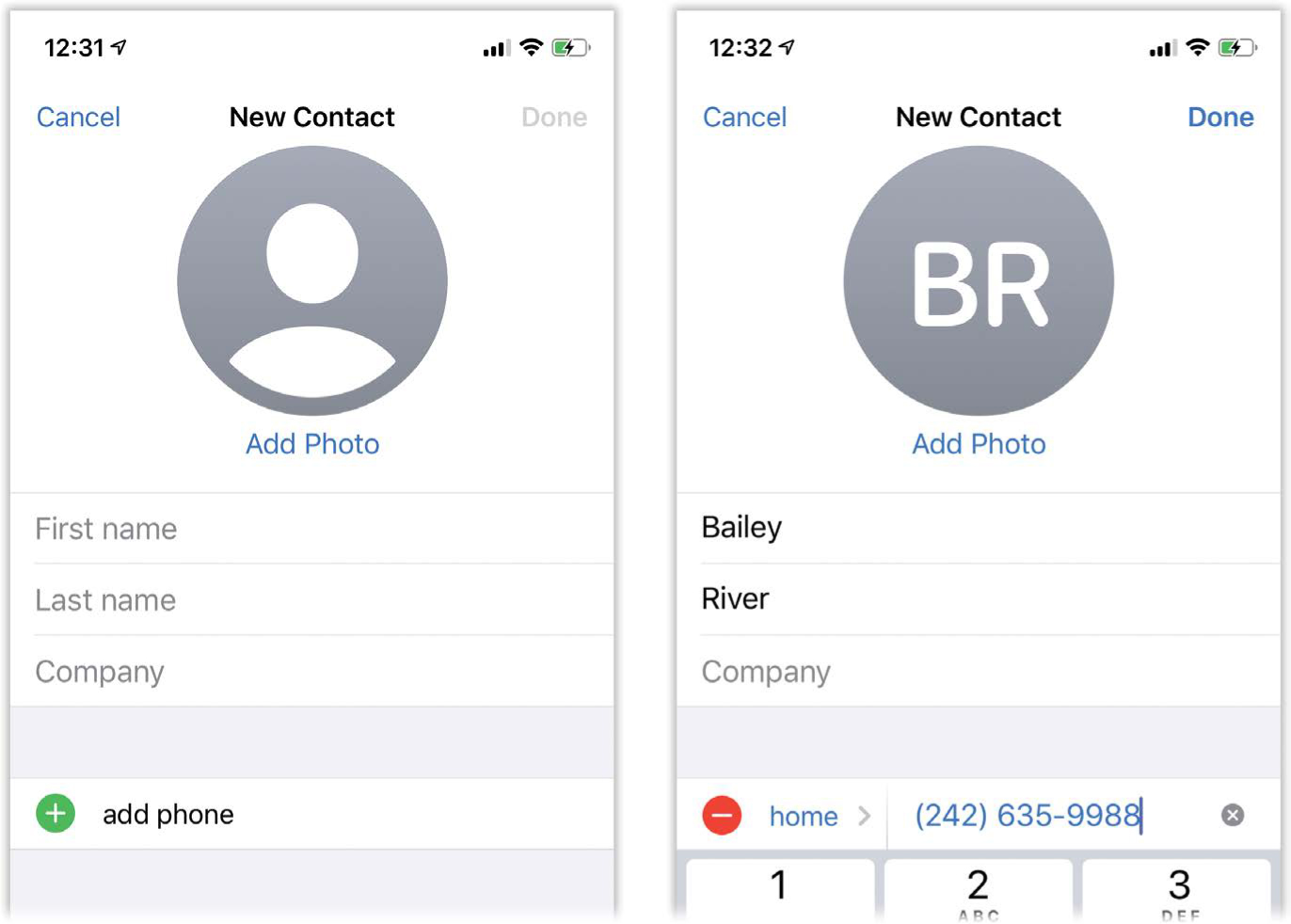
But if, in a pinch, on the road, at gunpoint, you have to add, edit, or remove a contact manually, here’s how to do it:
Make sure you’ve selected the right group or account, as described already. Now, on the Contacts screen, tap ![]() . You arrive at the New Contact screen, which teems with empty boxes.
. You arrive at the New Contact screen, which teems with empty boxes.
It shouldn’t take you long to figure out how to fill in this form: You tap in a box and type. But here are a few tips for data entry:
The keyboard opens automatically when you tap in a box. And the iPhone capitalizes the first letter of each word for you.
Phone numbers are special. When you enter a phone number, the iPhone adds parentheses and hyphens for you. (You can even enter text phone numbers, like 1-800-GO-BROWNS; the iPhone converts the letters to digits when it dials.)
If you need to insert a pause—for dialing access numbers, extension numbers, or voicemail passwords—type #, which introduces a two-second pause in the dialing. You can type several of them to create longer pauses.
To change the label for a number (“mobile,” “home,” “work,” and so on), tap the label that’s there now. The Label screen shows you your choices. There’s even a label called “iPhone,” so you and your buddy can gloat together.
TIP
If you scroll down the Label screen, you’ll see you can also create custom labels. You might prefer someone’s cellphone number to be identified as “cell” instead of “mobile,” for example. Or you might want to create a label that says “Skype,” “Google Voice,” “Line 2,” “Yacht Phone,” or “Bat Phone.” The secret: Tap Add Custom Label. (Once you’ve created a custom label, it’s there in the list of options for your use later.)
Expand-O-Fields mean you’ll never run out of room. Almost every field (empty box) on a Contacts card is infinitely expanding. That is, the instant you start filling in a field, another empty box (labeled
 add phone or whatever) appears right below it, so you can immediately add another phone number, email address, URL, or street address. (The only nonexpanding fields are First name, Last name, Company, Ringtone, Text Tone, Notes, and whatever oddball fields you add yourself.)
add phone or whatever) appears right below it, so you can immediately add another phone number, email address, URL, or street address. (The only nonexpanding fields are First name, Last name, Company, Ringtone, Text Tone, Notes, and whatever oddball fields you add yourself.)For example, when you first tap add phone, the phone-number box you get is labeled “home.” (If that’s not the right label, you can tap it to choose from one of almost a dozen others—or add a custom label.) A new add phone button appears so you’ll have a place to enter a second phone number for this person. When you do that, a third add phone button appears. And so on.
In other words, you can never run out of places to add more phone numbers, addresses, URLs, and social media profiles.
NOTE
Tapping add field at the bottom of this screen lets you add a new miscellaneous field, like Nickname or Department.
You can keep track of social. In iCloud accounts, there’s also the social profile field, where you can list somebody’s address for social media (Twitter, LinkedIn, Flickr, Facebook, and so on) and any communication apps you have installed (Messenger, Zoom, WhatsApp, Skype, Amazon Alexa). There’s an instant message field, too, where you can record addresses for chat networks Skype, MSN, and so on.
Relationships are here. Then there’s add related name. Here’s where you can list this person’s mother, father, spouse, partner, child, manager, sibling, and so on—or even specify a different type of relationship (tap the existing label and then Add Custom Label).
NOTE
As you are about to discover in Chapter 5, Siri knows all about relationships. You can tell her to “Call my mom” or “Text my boss.” Does the add related name feature mean you can now ask Siri to “Call Chris Robin’s manager”?
Alas, no. These fields work that way only for your own relationships.
You can add a photo of the person, if you like. Tap add photo. If you have a photo of the person on your phone already, tap All Photos. You’re taken to your photo collection, where you can find a good headshot.
Alternatively, tap
 to activate the iPhone’s built-in camera. Frame the person, and then tap the white camera button to snap the shot.
to activate the iPhone’s built-in camera. Frame the person, and then tap the white camera button to snap the shot.In either of those cases, you wind up at the Move and Scale screen (next page, right). Here you can frame up the photo so the person’s face is nicely sized and centered. Spread two fingers to enlarge the photo; drag your finger to move the image within the frame. Tap Use Photo; now you’re offered a bunch of color filters to enhance the shot. Tap one (or tap Original). Back on the info screen where you started, the photo now appears. Tap Edit if you want to duplicate the photo (so you can make further edits), edit the Move and Scale screen, or get rid of it altogether.
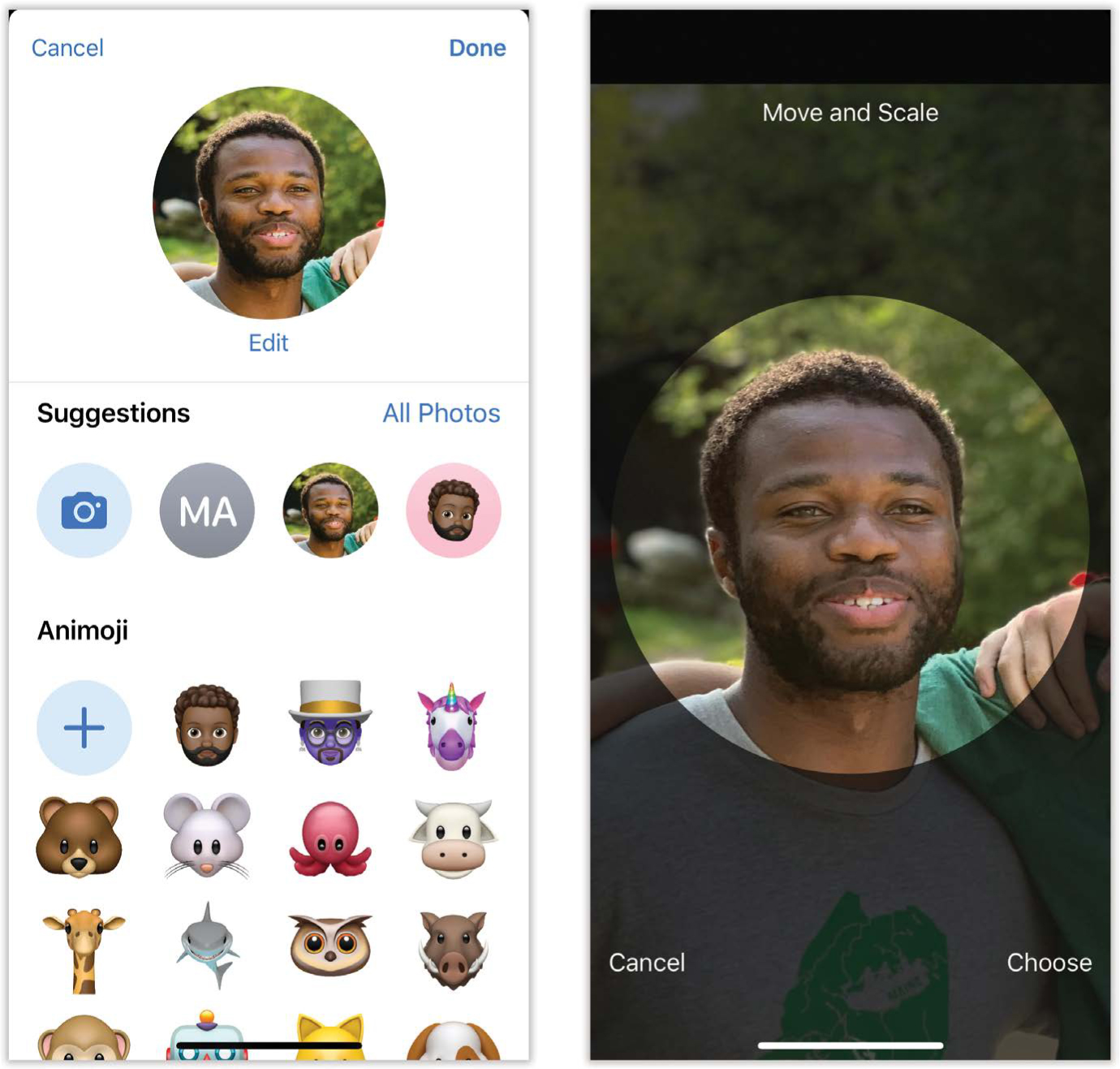
Instead of a photo, you’re also offered a wealth of Animoji (above, left)—Apple’s set of cute, cartoon, interactive animal faces, along with any you’ve created yourself (“Memoji (Face ID Phones)”). If you tap one of these, you’re asked to “Strike your favorite pose,” meaning make a face into the camera. The cartoon mimics your expression; tap the white, round shutter button to freeze the icon that way. If it looks good, make your adjustments on the Move and Scale screen, hit Choose, and then choose a background color. Tap Done.
From now on, this photo or Animoji will pop up whenever the person calls. It also appears next to the person’s name in your Favorites list.
You can choose a ringtone. You can choose a different ringtone for each person in your address book. The idea is that you’ll know by the sound of the ring who’s calling you.
NOTE
It’s one tone per person, not per phone number. Of course, if you really want one ringtone for your buddy’s cellphone and another for his home phone, you can always create a different Contacts card for each one.
To choose a ringtone, tap Default. On the next screen, tap any sound in the Ringtones or Alert Tones lists to sample them. (Despite the separate lists, in this context, these sounds are all being offered as ringtones.) When you’ve settled on a good one, tap Done to return to the info screen where you started.
TIP
Here, on the ringtone selection screen, you’re offered an Emergency Bypass switch. Turn it on to say, “Whenever this person calls or texts, I want my phone to ring or vibrate even if I’ve turned on Do Not Disturb” (“Do Not Disturb”).
You can specify a vibration pattern for incoming calls. This unsung feature lets you assign a custom vibration pattern to each person in your Contacts, so you know by feel who’s calling—without even removing the phone from your pocket, even if your ringer is off. It’s a surprisingly useful option.
To set it up, start on the Ringtone screen described already; tap Default next to the word Vibration. You’re offered a choice of canned patterns (Alert, Heartbeat, Quick, Rapid, and so on). But if you tap Create New Vibration, you can then tap the screen in whatever rhythm you like. It can be diddle diddle dee…or the opening notes to the Hallelujah Chorus…or the actual syllables of the person’s name. (“Maryanna Beckleheimer.” Can you feel it?)

The phone records your pattern, which you can prove to yourself by tapping Play. If you tap Save and name that pattern, then it becomes one of the choices when you choose a vibration pattern for someone in your Contacts. It’s what you’ll feel whenever this person calls you. Yes, it’s tactile caller ID. Wild.
You can also pick a text-message sound (and vibration). Just as you can choose sounds and vibrations for incoming phone calls, you can tap Text Tone to choose sounds and vibrations for incoming text messages and FaceTime invitations.
You can add new fields of your own. Very cool: If you tap add field at the bottom of the screen, then you go down the rabbit hole into Field Land, where you can add any of 13 additional info bits about the person whose card you’re editing: a prefix (like Mr. or Mrs.), a suffix (like M.D. or Esq.), a nickname, a job title, a phonetic pronunciation for people with uncommon names, and so on.
When you tap one of these labels, you return to the info screen, where you’ll see that the iPhone has inserted the new, empty field in the most intelligent spot. For example, if you add a phonetic first name, that box appears just below the “First name” box. The keyboard opens so you can fill in the blank.
You can link and unlink Unified Contacts. As noted earlier, your phone can sync up with different accounts. Your Contacts app might list four sets of names and numbers: one stored on your phone, one from an iCloud account, one from Facebook, and a fourth from your corporate Exchange server at work. In the old days, therefore, certain names might have shown up in the Contacts list two or three times—not an optimal situation.
Now, as a favor to you, the iPhone displays each person’s name only once in that master list. If you tap that name, you open a unified information screen for that person. It includes all the details from all the underlying contact cards.
NOTE
The iPhone combines cards only if the first and last names are exactly the same. If there’s a difference in name, suffix, prefix, or middle name, then no unifying takes place. Remember, too, that you see the unification only if you view the All Contacts list.
To see which cards the iPhone is combining for you, scroll to the bottom of the card. There the Linked Contacts section shows you which cards have been unified.
You can tap a listing to open the card in the corresponding account. For that matter, you can manually link a card, too; tap Edit, tap link contacts, and then choose a contact to link to this unified card—even if the name isn’t a perfect match.
NOTE
It’s OK to link Joe Carnelia’s card with Joseph Carnelia’s card—they’re probably the same person. But don’t link up different people’s cards. Remember, the whole point is to make the iPhone combine all the phone numbers, email addresses, and so on onto a single card—and seeing two sets on one card could get confusing fast.
This stuff gets complex. But, in general, the iPhone tries to do the right thing. For example, if you edit the information on the unified card, you’re changing that information only on the card in the corresponding account. (Unless you add information to the unified card. In that case, the new data tidbit is added to all the underlying source-account cards.)
NOTE
To delete any info bit from a Contacts card, tap the
 next to it, and then tap the Delete button to confirm.
next to it, and then tap the Delete button to confirm.
Adding a Contact on the Fly
There’s actually another way to add someone to your Contacts list—a faster, on-the-fly method that’s more typical of cellphones. Start by bringing the phone number up on the screen:
In the Phone app, open the Keypad. Tap in the number, and then tap Add Number.
You can also add a number that’s in your Recents (recent calls) list, storing it in Contacts for future use. Tap the
 button next to the name.
button next to the name.
In both cases, finish up by tapping Create New Contact (to enter this person’s name for the first time) or Add to Existing Contact (to add a new phone number to the card of someone who’s already in your list). Off you go to the Contacts editing screen shown in “Adding to the Contacts List”.
Editing Someone
To make corrections or changes, tap the person’s name in the Contacts list. In the upper-right corner of the info card, tap Edit.
You return to the screens already described, where you can make whatever changes you like. After you tap Done (or Cancel), you can return to the Contacts list by swiping to the right.
Deleting Someone
Truth is, you’ll probably add people to your address book far more often than you’ll delete them. After all, you meet new people all the time—but you delete them primarily when they die, move away, or dump you.
To zap someone, tap the name in the Contacts list and then tap Edit. Scroll down, tap Delete Contact, and confirm by tapping Delete Contact again. (Weirdly, the Delete Contact option doesn’t appear if you open someone’s info card from the Recents or Favorites lists—only from the main Contacts list.)
Sharing a Contact
There’s a lot of work involved in entering someone’s contact information. It’s a nice touch, therefore, that you can spare the next guy all that effort—by sending a fully formed electronic business card to him.
To do that, open the contact’s card—it can be yours or anyone’s—and tap Share Contact. Here’s the usual array of ways that you can electronically send things to other phones—the Share sheet, described in “The Share Sheet”. You can send this contact “card” by AirDrop, Messages, Mail, and so on.
Tap your choice, address the message (to an email address or, for a message, a cellphone number), and send it. The recipient, assuming he has a half-decent smartphone or address-book program on the receiving end, can install that person’s information with a single tap on the attachment.
The Keypad
The fourth way to place a call is to tap Keypad at the bottom of the screen. The standard iPhone dialing pad appears.
To make a call, tap out (or paste) the phone number—use the ![]() key or a left swipe to backspace if you make a mistake—and then tap the
key or a left swipe to backspace if you make a mistake—and then tap the ![]() button.
button.
You can also use the keypad to enter a phone number into your Contacts list, thanks to the Add Number button, described earlier.
TIP
If you tap the ![]() button before touching any digits, you call up the last number you dialed on the keypad, ready to call again.
button before touching any digits, you call up the last number you dialed on the keypad, ready to call again.
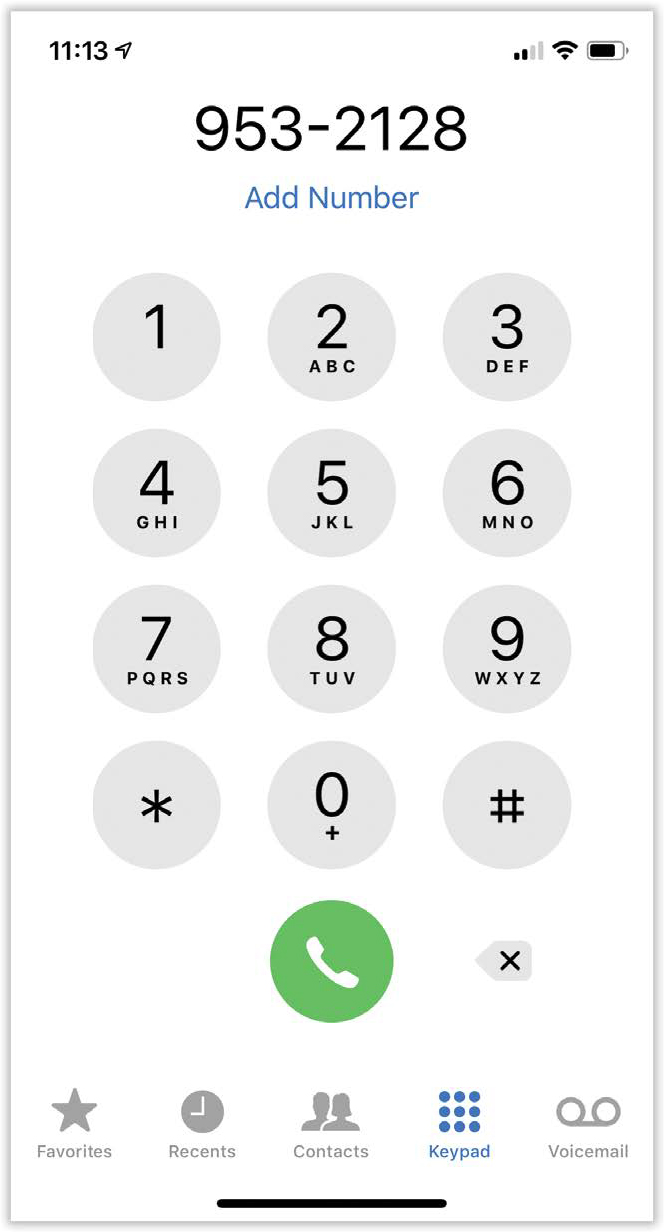
Visual Voicemail
On the iPhone, you don’t dial in to check for answering-machine messages people have left for you. You don’t enter a password. You don’t sit through some Ambien-addled recorded voice saying, “You have…17…messages. To hear your messages, press 1. When you have finished, you may hang up…”
Instead, whenever somebody leaves you a message, the phone wakes up, and a notification lets you know who it’s from. You also hear a sound (unless you’ve turned on the silencer switch).
That’s your cue to open Phone → Voicemail. There you see all your messages in a tidy chronological list. (The list shows the callers’ names if they’re in your Contacts list; otherwise it shows their numbers.) You can listen to them in any order—you’re not forced to listen to three long-winded friends before discovering that there’s an urgent message from your boss. It’s a game changer.
iOS even makes an attempt to transcribe your voicemails—to understand them and type out what they say. It’s pretty crude, with lots of wrong and missing words. But it’s usually enough to get the gist.
Setup
To access your voicemail, open the Phone app; tap Voicemail.
The very first time you visit this screen, the iPhone prompts you to make up a numeric password for your voicemail account—don’t worry, you’ll never have to enter it again, unless you plan to actually dial in for messages (“Dialing In for Messages”). Record a “Leave me a message” greeting.
You have two options for the outgoing greeting:
Default. If you’re microphone-shy, or if you’re famous and don’t want stalkers calling just to hear your famous voice, then use this option. It’s a prerecorded female voice that says, “Your call has been forwarded to an automatic voice message system. 212-661-7837 is not available.” Beep!
Custom. This option lets you record your own voice saying, for example, “You’ve reached my iPhone 11 Pro. You may begin drooling at the tone.” Tap Record, hold the iPhone to your head, say your line, and then tap Stop.
Check how it sounds by tapping Play.
Then just wait for your fans to start leaving you messages!
Using Visual Voicemail
In the voicemail list, a blue dot (![]() ) indicates a message you haven’t yet played.
) indicates a message you haven’t yet played.
TIP
You can work through your messages even when you’re out of cellular range—on a plane, for example—because the recordings are stored on the iPhone itself.
When you tap the name of a message, you instantly see the date and time it came in, the person’s name (if it’s in your Contacts) or the cellphone’s registered city and state (if not), and a rough transcription. The Play slider tells you how many seconds long the message is.
And all the controls you need are right there, surrounding the message you tapped:
Share (
 ). Yes, you can send a voicemail recording to someone else (or to your laptop)—by email, text message, or whatever (“The Share Sheet”). Preserving important voicemails like this can be supremely useful—in, for example, a lawsuit.
). Yes, you can send a voicemail recording to someone else (or to your laptop)—by email, text message, or whatever (“The Share Sheet”). Preserving important voicemails like this can be supremely useful—in, for example, a lawsuit.Open this person’s Contact card by tapping
 .
.The transcript. This is a crude transcript (Apple labels it beta, after all). There’s no punctuation. There may be missing ____ and phrases. Some words might be completely wrong. But it’s usually good enough that you can tell if a message is some robocall asking for money, or a message from the school nurse saying your kid has a broken rib.
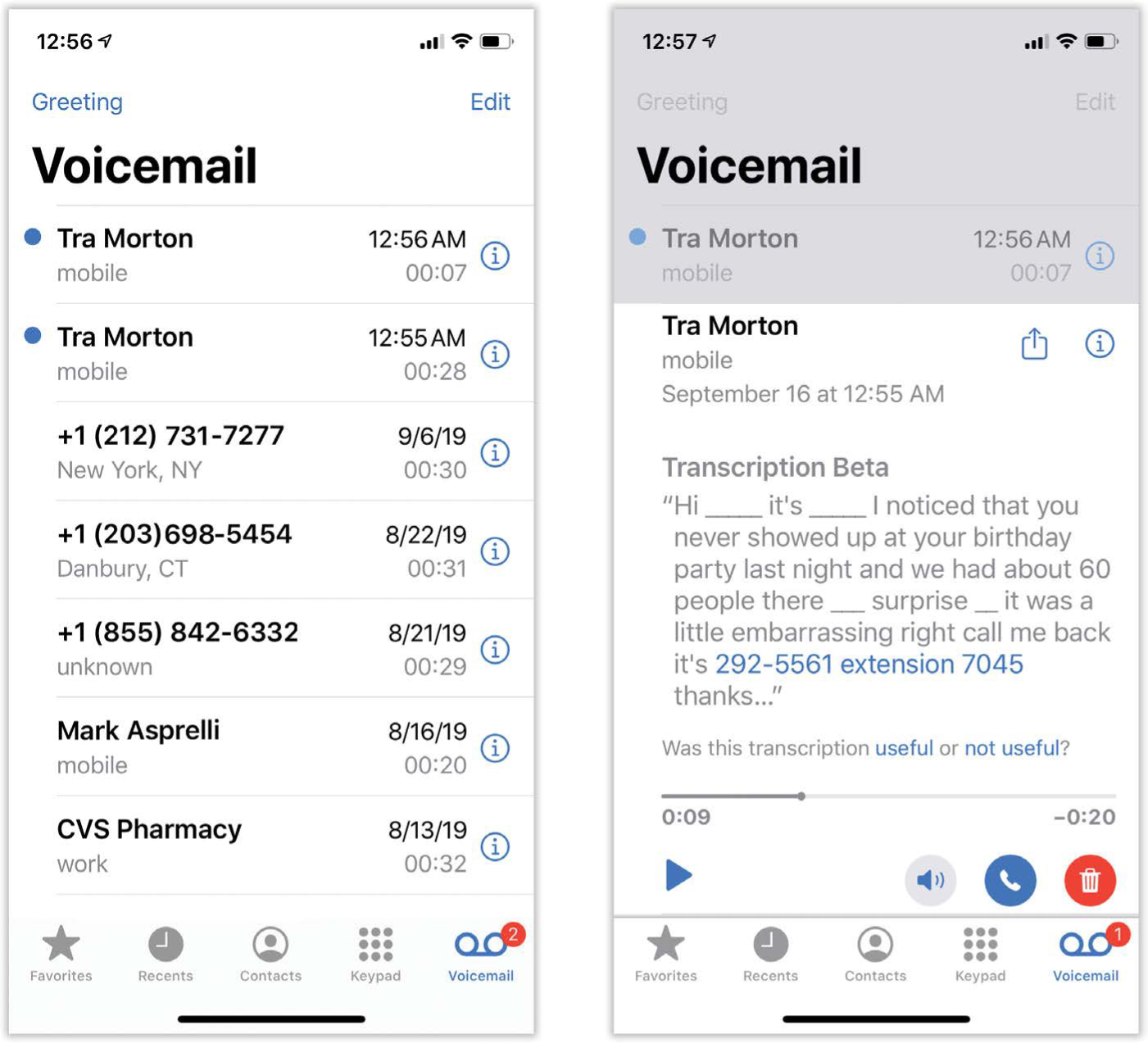
 . Tap to listen to the message.
. Tap to listen to the message. . As the name “Visual Voicemail” suggests, you’re looking at your voicemail list—which means you’re not holding the phone up to your head. The first time people try using Visual Voicemail, therefore, they generally hear nothing!
. As the name “Visual Voicemail” suggests, you’re looking at your voicemail list—which means you’re not holding the phone up to your head. The first time people try using Visual Voicemail, therefore, they generally hear nothing!But if you hit Speaker (
 ) before you tap
) before you tap  , you can hear the playback and continue looking over the list.
, you can hear the playback and continue looking over the list. . Tap to return the call. Very cool—you never even encounter the person’s phone number.
. Tap to return the call. Very cool—you never even encounter the person’s phone number. . You might want to keep the list manageable by deleting old messages. That’s what this button does.
. You might want to keep the list manageable by deleting old messages. That’s what this button does.If you have a lot of messages to delete, here’s a faster way: Swipe across the first one’s name right to left, and then tap Delete. The message disappears instantly. You can work down the list quickly this way.
NOTE
Deleting a message like this doesn’t really delete it; it only lands in the Deleted Messages folder at the bottom of the list, where it sits for a couple of months before being auto-deleted. In other words, Deleted Messages is a safety net, like the Trash or the Recycle Bin on a computer.
On the Deleted screen, you can undelete a message that you don’t want to lose yet (that is, move it back to the Voicemail screen—tap it and then tap
 ) or tap Clear All to erase these messages for good.
) or tap Clear All to erase these messages for good.Rewind, Fast Forward. Drag in the scrubber bar (beneath the message) to skip backward or forward in the message. It’s a great way to replay something you didn’t catch the first time.
To collapse the expanded message, tap another message in the list, if it’s visible, or just tap the caller’s name.
Even before you’ve expanded a message’s row to view the ![]() ,
, ![]() ,
, ![]() , and
, and ![]() buttons, a few other Visual Voicemail buttons are awaiting your inspection:
buttons, a few other Visual Voicemail buttons are awaiting your inspection:
Greeting. Tap Greeting (upper-left corner) to record your voicemail greeting.
Call Details. Tap
 to open the info screen—the Contacts card—for the message that was left for you.
to open the info screen—the Contacts card—for the message that was left for you.If it was left by somebody who’s in your Contacts list, you can see which of that person’s phone numbers the call came from (indicated in blue type), plus a
 if that number is in your Favorites list. Oh, and you can add this person to your Favorites list at this point by tapping Add to Favorites (at the bottom of the screen).
if that number is in your Favorites list. Oh, and you can add this person to your Favorites list at this point by tapping Add to Favorites (at the bottom of the screen).You can return the call right from the info screen, fire off a text message, send an email, place a FaceTime audio or video call, or even send that person some money via Apple Pay (“Apple Pay”).
If the caller’s number isn’t in Contacts, you’re offered a Create New Contact button and an Add to Existing Contact button, so you can store it for future reference.
Dialing In for Messages
Gross and pre-iPhonish though it may sound, you can also dial in for your messages from another phone.
To do that, dial your iPhone’s number. Wait for the voicemail system to answer. As your own voicemail greeting plays, dial * (or # if you have Verizon), your voicemail password, and then #.
You hear the Uptight Carrier Lady announce how many messages you have, and then she’ll start playing them for you. After you hear each message, she’ll offer you the following options (but you don’t have to wait for her to announce them):
To delete the message, press 7.
To save it, press 9.
To replay it, press 4. (On T-Mobile, it’s 1.)
Conveniently enough, these keystrokes are the same on Verizon, Sprint, and AT&T.
TIP
If this whole Visual Voicemail thing freaks you out, you can also dial in for messages right from your own iPhone. Open the keypad and hold down the 1 key, just as though it were a speed-dial key on any normal phone.
After a moment, the phone connects; you’re asked for your password, and then the messages begin to play back, just as described already.
Answering Calls
When someone calls your iPhone, you’ll know it; three out of your five senses are alerted. Depending on how you’ve set up your phone, you’ll hear a ring, feel a vibration, and see the caller’s name and photo on the screen. (Smell and taste will have to wait until iOS 14.)
NOTE
For details on Vibrate mode and on choosing a ringtone, see “Personal Hotspot”.
How you answer depends on what’s happening at the time:
If the iPhone is asleep or locked, the screen lights up and says slide to answer. If you slide your finger as indicated by the arrow, you simultaneously unlock the phone and answer the call.
If you’re using the iPhone, tap the green Accept button. Tap the red hang-up button when you’ve both said enough.
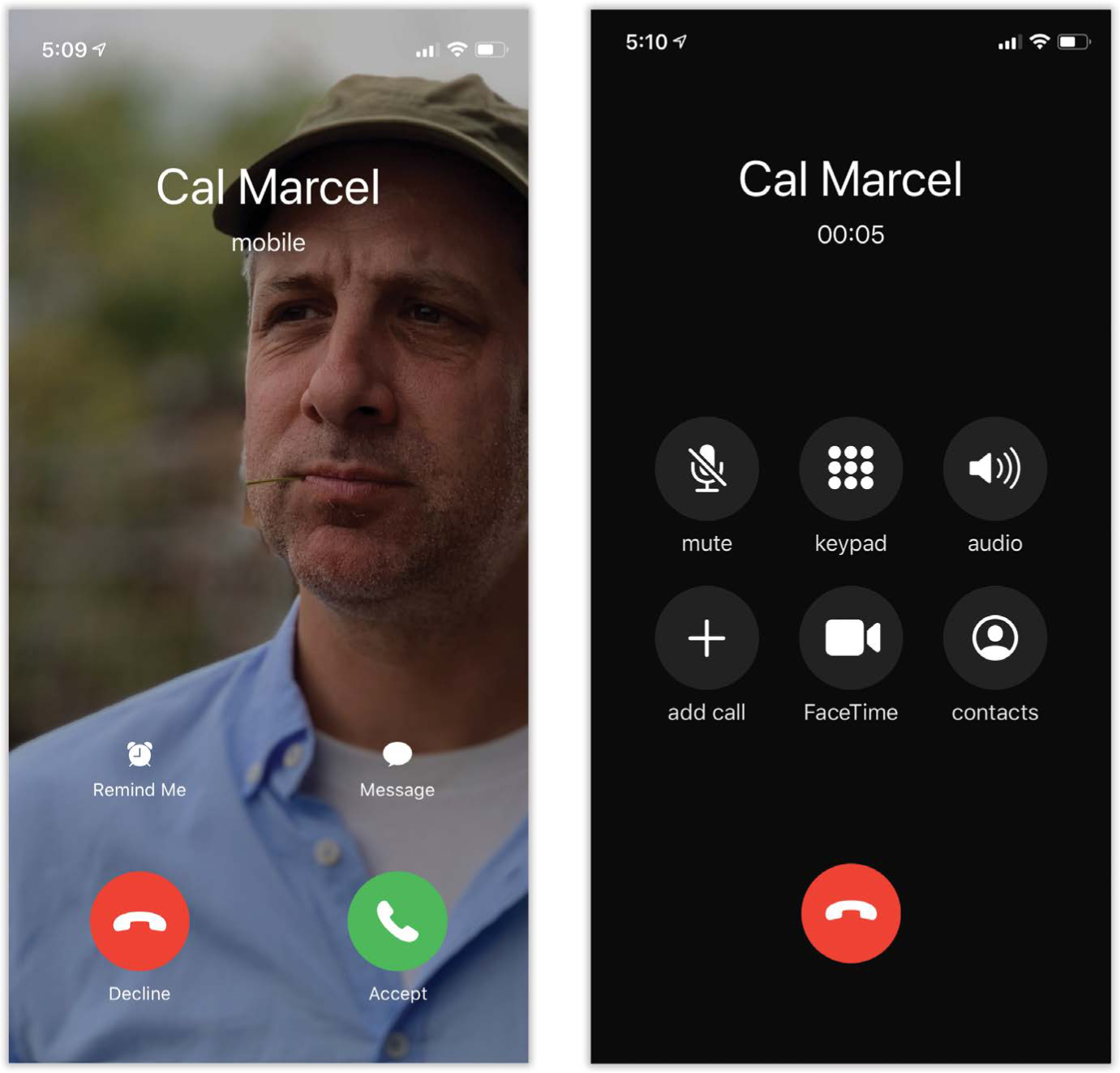
If you’re wearing earbuds, the music fades out and then pauses; you hear the ring both through the phone’s speaker and through your earbuds. (If you have a vibration pattern set up, then the phone vibrates, too). Answer by squeezing the clicker on the earbud cord or by using either of the methods already described.
NOTE
If you’re wearing Apple’s AirPods, you hear the ringing only through the ’pods, not through the phone’s speakers. Answer by double-tapping the outside of one of the AirPods.
When the call is over, you can click again to hang up—or just wait until the other guy hangs up. Either way, the music fades in again and resumes from the spot where you were so rudely interrupted.
Same thing if you were watching a video or listening to a podcast; it pauses for the duration of the call and resumes when you hang up.
Online and on the Phone, Together
Don’t forget that the iPhone is a multitasking master. Once you’re on the phone, you can dive into any other program—to check your calendar, for example—without interrupting your call.
You may even be able to use the phone’s internet functions (web, email, apps, and so on) without interrupting the call. To be precise, you can be online and on the phone simultaneously if:
You’re in a Wi-Fi hotspot.
You have AT&T, T-Mobile, or Sprint in a VoLTE coverage area, and you have VoLTE calling turned on (see “A Word About VoLTE”).
In other words, if you have Verizon (non-VoLTE) or Sprint (in a non-VoLTE area), and if you’re not in a Wi-Fi hotspot, then you can’t get online until the call is complete.
Not Answering Calls
Maybe you’re in a meeting. Maybe you’re driving. Maybe the call is from someone you really don’t want to deal with. Fortunately, you have all kinds of ways to slam the cellular door in somebody’s face.
Silencing the Ring
You might need a moment before you can answer the call, or you need to exit a meeting or put in the earbuds. In those cases, you can stop the ringing and vibrating by pressing one of the physical buttons on the edges (the side button or either volume key). The caller still hears the phone ringing, and you can still answer it within the first four rings, but at least the sound won’t be annoying those around you.
(This assumes, of course, that you haven’t just flipped the silencer switch.)
Ignore It—or Dump It to Voicemail
If you wait long enough (four rings), the call goes to voicemail (even if you silence the ringing as described already).
Or you can dump it to voicemail immediately (instead of waiting for the four rings). How you do that depends on the setup:
If the iPhone is asleep or locked, tap the side button twice fast.
If you’re using the iPhone, tap the Decline button on the screen.
If you’re wearing the earbuds, squeeze the earbuds clicker for two seconds. You hear two low beeps, meaning: “OK, Master; dumped.”
Of course, if your callers know you have an iPhone, they’ll also know you’ve deliberately dumped them into voicemail—because they won’t hear all four rings.
Auto-Dump to Voicemail
For the first time, Apple has provided you with a sliver of a weapon against robocallers and telemarketers. It’s called Silence Unknown Callers, and it’s described in “Messages”.
Respond with a Text Message
Whenever your phone rings, the screen bears a small white Message button (shown in “Online and on the Phone, Together” at left). If you tap it, you get a choice of three canned text messages. Tapping one immediately dumps the caller to voicemail and sends the corresponding text message to the phone that’s calling you. If you’re driving or in a meeting, this feature is a lot more polite and responsive than just dumping the poor slob to voicemail.
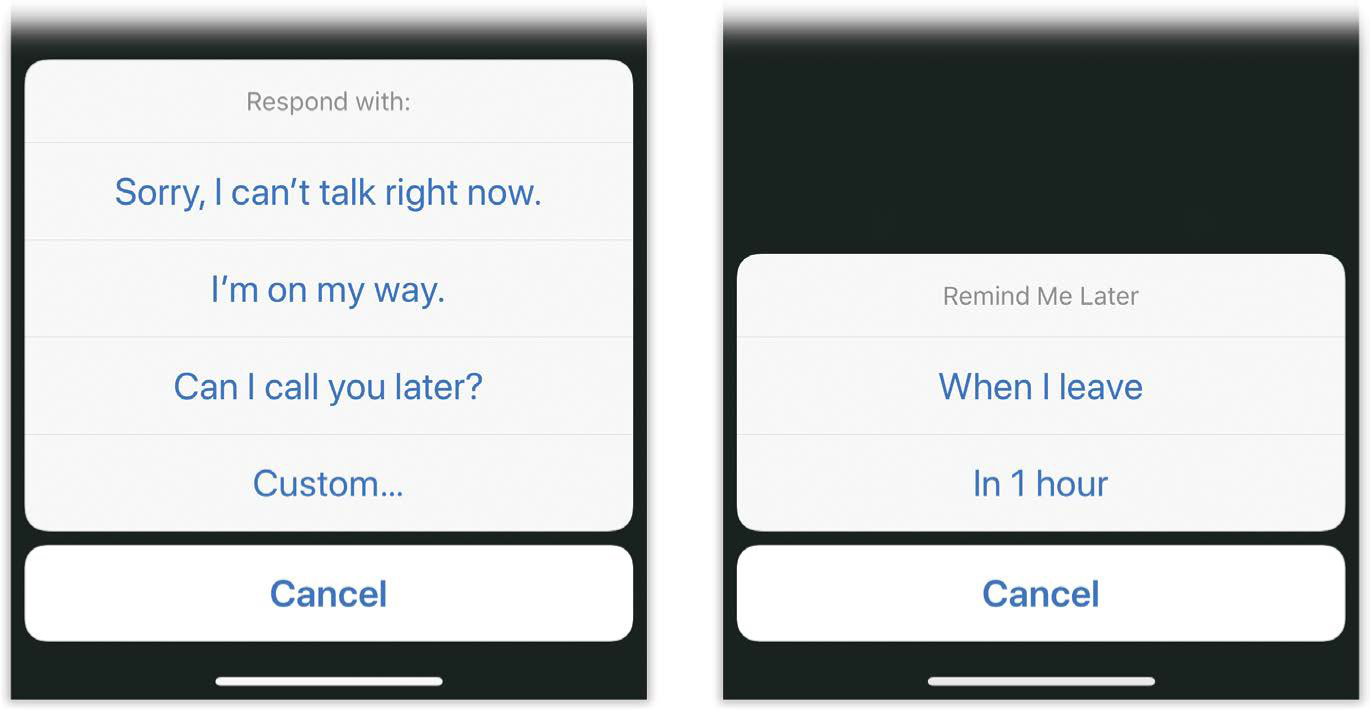
TIP
You can edit any of these three canned messages; they don’t have to say, “Sorry, I can’t talk right now,” “I’m on my way,” and “Can I call you later?” forever. To do that, open Settings → Phone, tap Respond with Text, and replace the text in the three placeholder boxes.
The fourth button, Custom, lets you type or dictate a new message on the spot. (“I’m in a meeting and, frankly, your call isn’t worth getting fired for” comes to mind.)
Remind Me Later
The trouble with Respond with Text, of course, is that it sends a text message. What if the caller is using a landline that can’t receive text messages? Fortunately, you have another option: Remind Me.
Tapping this button offers you one time-based option, In 1 Hour (which sets up a reminder to return the call an hour from now), and up to three location-based options (previous page, right): When I leave, When I get home, and When I get to work. (The home and work options appear only if the iPhone knows your home and work addresses—because you’ve entered them in your own card in Contacts.)
These options use the phone’s GPS circuitry to detect when you’ve left your current inconvenient-to-take-the-call location, whether it’s a job interview, a first date, or an outhouse.
Fun with Phone Calls
The iPhone makes it pitifully easy to perform stunts like turning on the speakerphone, putting someone on hold, taking a second call, and so on. Here are the options you get when you’re on a call.
Mute
Tap this button to mute your own microphone, so the other guy can’t hear you. (You can still hear him, though.) Now you have a chance to yell upstairs, to clear the phlegm from your throat, or to do anything else you’d rather the other party not hear. Tap again to unmute.
Keypad
Sometimes you have to input touch-tones. For example, that’s usually how you operate home answering machines when you call in for messages, and it’s often required by automated banking, reservations, and conference-call systems.
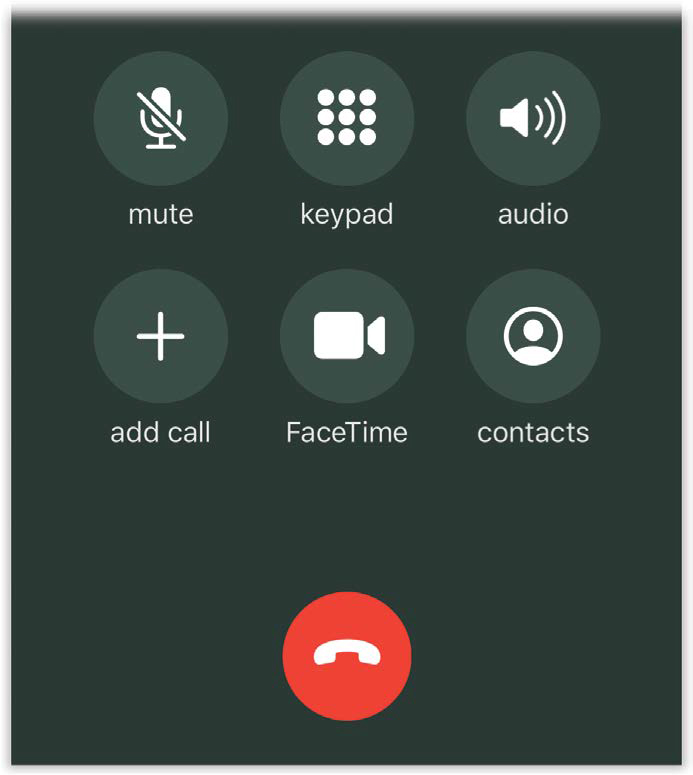
Tap keypad to produce the traditional iPhone dialing pad. Each digit you touch generates the proper touch-tone. When you’re finished, tap Hide to return to the dialing-functions screen, or End if your conversation is complete.
Speaker (Audio)
For most people, tapping this button turns on the built-in speakerphone—a great hands-free option.
But if the earbuds are plugged in, or a Bluetooth headset or speaker is connected, or you have a Mac associated with the phone (“Mac as Speakerphone”), the button says audio instead of speaker. You get a little menu of audio sources for your call, including speakerphone and whatever other audio sources are available.
When you tap the button, it turns white. Now you can put the iPhone down on a table or a counter and have a conversation with both hands free. Tap speaker (or audio, and then iPhone) again to channel the sound back into the built-in earpiece.
Add Call (Conference Calling)
The iPhone is all about software, baby, and that’s nowhere more apparent than in its facility at handling multiple calls at once.
The simplicity and reliability of this feature put other cellphones to shame. Never again, in attempting to answer a second call, will you have to tell the first person, “If I lose you, I’ll call you back.”
As you’ll read, however, the details depend on whether you’re using a GSM phone (AT&T or T-Mobile) or a CDMA phone (Verizon or Sprint).
Suppose you’re on a call. Here are some of the tricks you can do:
Make an outgoing call. Tap add call. The iPhone puts the first person on hold—neither of you can hear the other—and returns you to the Phone app and its various phone-number lists. You can now make a second call in any way you want. The top of the screen makes clear that the first person is still on hold as you talk to the second.
Receive an incoming call. What happens when a second call comes in while you’re already on a call?
To answer on a GSM phone, tap End Call + Answer. On a CDMA phone, tap End Current Call; the new call makes the phone ring again, at which point you can answer it normally. Weird but true.
You can also tap End Current Call (answer the incoming call, hang up on the first) or Decline Incoming Call (send it to voicemail).
When you’re on two calls at once, the top of the screen identifies both other parties. Two new buttons appear, too:
swap lets you flip between the two calls. At the top of the screen, you see the names or numbers of your callers. One says Hold (the one who’s on hold, of course) and the other bears a time counter, which lets you know whom you’re actually speaking to (next page, left).
Think how many movie comedies have relied on the old “Whoops, I hit the wrong button and now I’m bad-mouthing somebody directly instead of behind his back!” gag. That can’t happen on the iPhone.
You can swap calls by tapping swap or by tapping the Hold person’s name or number.
merge calls combines your two calls so all three of you can converse at once. The top of the screen announces the names of your callers.
TIP
On a GSM phone, you can tap ![]() next to someone’s name; at this point, you can drop someone from the call by tapping End or talk privately with someone by tapping Private. Tap Merge Calls to return to the group call.
next to someone’s name; at this point, you can drop someone from the call by tapping End or talk privately with someone by tapping Private. Tap Merge Calls to return to the group call.
This business of combining calls doesn’t have to stop at two. At any time, you can tap Add Call, dial a third number, and then tap Merge to combine it with your first two. And then a fourth call, and a fifth. With you, that makes six people on the call.
Then your problem isn’t technological; it’s social, as you try to conduct a meaningful conversation without interrupting one another.
FaceTime
Tap this button to switch from your current phone call into a face-to-face video call, using the FaceTime app described starting in “Get Your Ringtones Back”.
(This feature requires that both you and the other guy have iPhones, iPads, iPod Touches, or Macs.)
Hold
The FaceTime button appears in place of what, on earlier iPhones, was the Hold button. But you can still trigger the Hold function—by holding down the Mute button for a couple of seconds. Now neither you nor the other guy can hear anything. Tap again to resume the conversation.
Contacts
This button opens the address book program so you can look up a number or place another call.
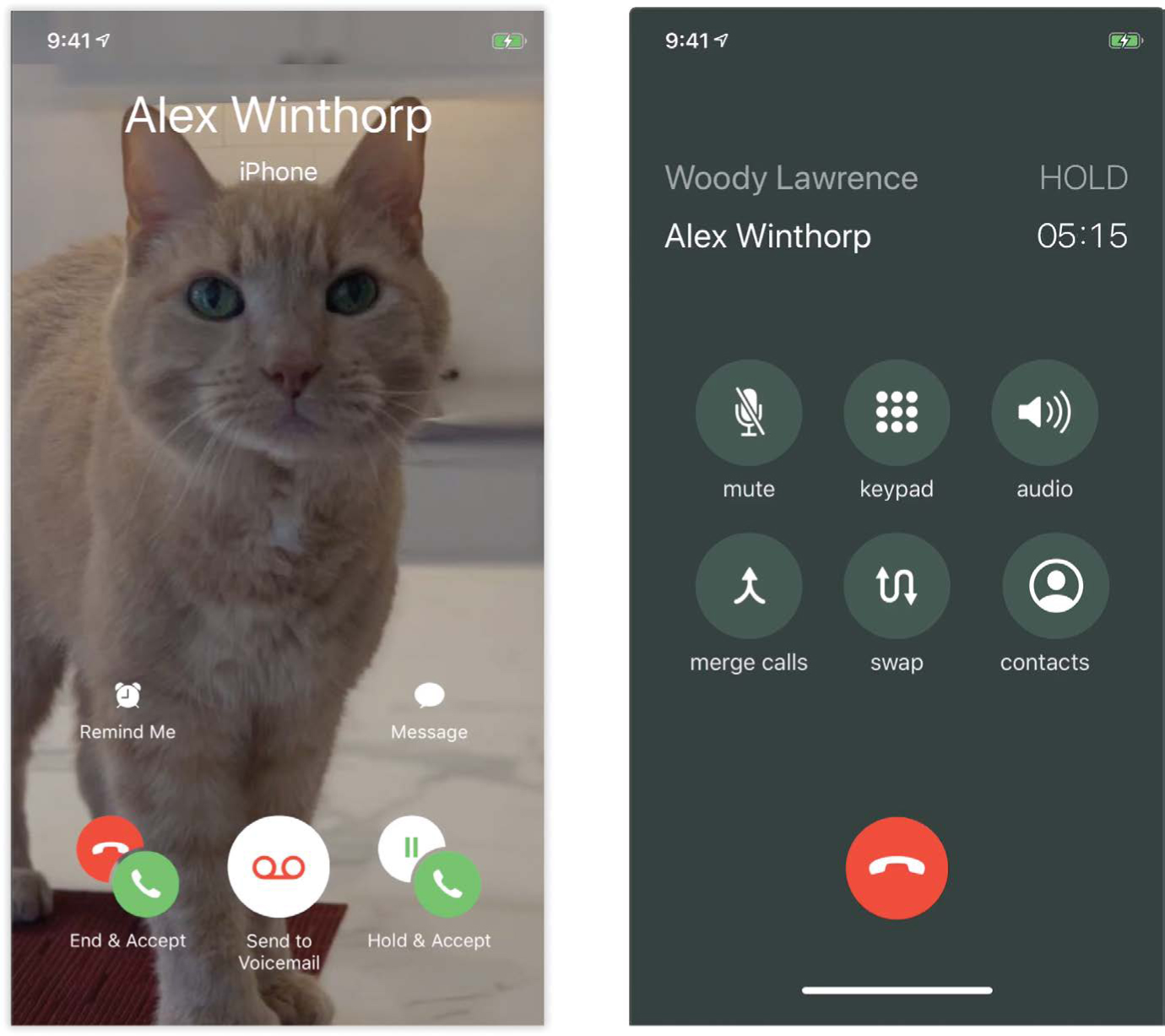
Call Waiting
What happens when you’re on one phone call, and a second call comes in? On the iPhone, the phone rings (and/or vibrates) as usual, and the screen displays the name or number of the caller, as usual. Buttons on the screen offer you three choices (facing page, left):
End & Accept. Hangs up on the first call and takes the second one.
Hold & Accept. This is the traditional call-waiting effect. You say, “Can you hold on a sec? I’ve got another call,” to the first caller. The iPhone puts her on hold, and you connect to the second caller.
At this point, you can jump back and forth between the two calls, or you can merge them into a conference call.
Send to Voicemail. The incoming call goes straight to voicemail. Your first caller has no idea anything has happened.
On AT&T phones, you can turn off call waiting (Settings → Phone → Call Waiting), so that additional incoming calls go straight to voicemail. If you have T-Mobile, Sprint, or Verizon, then you can turn off call waiting only one call at a time; just dial *70 before you dial the number. You won’t be disturbed by call-waiting beeps while you’re on that important call.
Call Forwarding
Here’s a pretty cool feature you may not have known you had. It lets you route all calls made to your iPhone number to a different number. How is this useful? Let us count the ways:
When you’re home. You can have your cellphone’s calls ring your home number so you can use any extension in the house, or so you don’t miss any calls while the iPhone is turned off.
When you send your iPhone to Apple for repair. You can forward the calls you would have missed to your home or work phone number.
When you’re overseas. You can forward calls to one of the web-based services that answers your voicemail and sends it to you as an email attachment (like Google Voice).
When you’re going to be in a place with little or no cell coverage. Let’s say you’re hiking in Alaska. You can have your calls forwarded to your hotel or to a friend’s cellphone. (Forwarded calls eat up your allotment of minutes, though.)
You have to turn on call forwarding while you’re still in an area with cell coverage. Here’s how:
AT&T. Tap Settings → Phone → Call Forwarding, turn call forwarding on, and then tap in the new phone number. That’s all there is to it—your iPhone will no longer ring. At least not until you turn the same switch off again.
Verizon, Sprint, T-Mobile. On the dialing pad, dial *72, plus the number you’re forwarding calls to. Then tap
 . (To turn off call forwarding, dial *73, and then tap
. (To turn off call forwarding, dial *73, and then tap  .)
.)
Caller ID
Caller ID is another classic cellphone feature. It displays the phone number of the incoming call (and sometimes the name of the caller).
The only thing worth noting about the iPhone’s implementation of caller ID is that you can prevent your number from appearing when you call other people’s phones:
AT&T. Tap Settings → Phone → Show My Caller ID, and then tap the on/off switch.
Verizon, Sprint, T-Mobile. You can disable caller ID only for individual calls. For example, if you’re calling your ex, you might not want your number to show up on his phone. Just dial *67 before you dial the number. (Caller ID turns on again for subsequent calls.)
Custom Ringtones
The iPhone comes with more than 50 creative and intriguing ringing sounds, from an old car horn to a peppy marimba lick (see “Personal Hotspot”). You can also buy ready-made pop-music ringtones from Apple for $1.29 each. (On your iPhone, open the iTunes Store app. Tap More → Tones).
You can also make up custom ring sounds, either to use as your main iPhone ring or to assign to individual callers in your Contacts list. All kinds of free or cheap apps are available for doing that, with names like Ringtone Designer Pro 2.0 and Ringtones for iPhone; they let you make ringtones out of songs you already own, or even sounds you record yourself.
You can also use GarageBand, a free Apple program available for iOS or Mac. For instructions, see this chapter’s free online appendix, “Making Custom Ringtones.” It’s a PDF available on this book’s “Missing CD” page at missingmanuals.com.
TIP
One feature blatantly missing on the iPhone is a “vibrate, then ring” option for incoming calls. That’s where the phone first vibrates silently to get your attention—and begins to ring only if you haven’t responded after, say, 10 seconds.
GarageBand offers the solution: Create a ringtone that’s silent for the first 10 seconds and only then plays a sound. Then set your iPhone to vibrate and ring. When a call comes in, the phone plays the ringtone immediately as it vibrates—but you won’t hear anything until after the silent portion of the ringtone has been “played.”
Get Your Ringtones Back
If you had custom ringtones in previous versions of iOS, but they no longer show up, you have two options:
If they came from the iTunes store, re-download them. (On the phone, open Settings → Sounds & Haptics → Ringtones, and tap Download All Purchased Tones.)
If they’re on your computer, reinstall them. Connect your phone to your computer, open iTunes, and drag the ringtone files into the left-side sidebar, where your phone’s name appears. (They’re in your Music → iTunes → iTunes Media → Tones folder.) Details are at support.apple.com/en-us/HT201593.
FaceTime Video Calls
Your iPhone, as you’re probably aware, has cameras both on the back and on the front. And that can mean only one thing: Video calling has arrived.
The picture and audio are generally rock-solid, with very little delay. Now Grandma can see the baby, or you can help someone shop from afar, or you can supervise brain surgery from thousands of miles away (some medical training recommended).
You can enjoy these Jetsons fantasies not just when calling other iPhones; you can also make video calls between iPhones and iPads, iPod Touches, and Macs. You can even place these calls when you’re not in a Wi-Fi hotspot, over the cellular airwaves, when you’re out and about.
FaceTime couldn’t be easier to fire up—in many different ways:
From Siri. The quickest way to start a video call may be simply to say, “FaceTime Mom,” “FaceTime Chris Taylor,” or whatever.
From Favorites. Whenever you designate someone’s FaceTime contact info as a favorite, a new entry appears in the Phone app’s Favorites list (“The Favorites List”).
When you’re already on a phone call with someone. This is a good technique when you want to ask first if the other guy wants to do video, or when you’ve been chatting and suddenly there’s some reason to do video. In any case, there’s nothing to it: Just tap the FaceTime button that’s right on the screen when you pull the phone away from your face. (Your buddy can either accept or, if he just got out of the shower, decline.)
From the FaceTime app. You can also start up a video chat without placing a phone call first. That’s handy when you have Wi-Fi but no cell signal; FaceTime can make the call even when Verizon can’t.
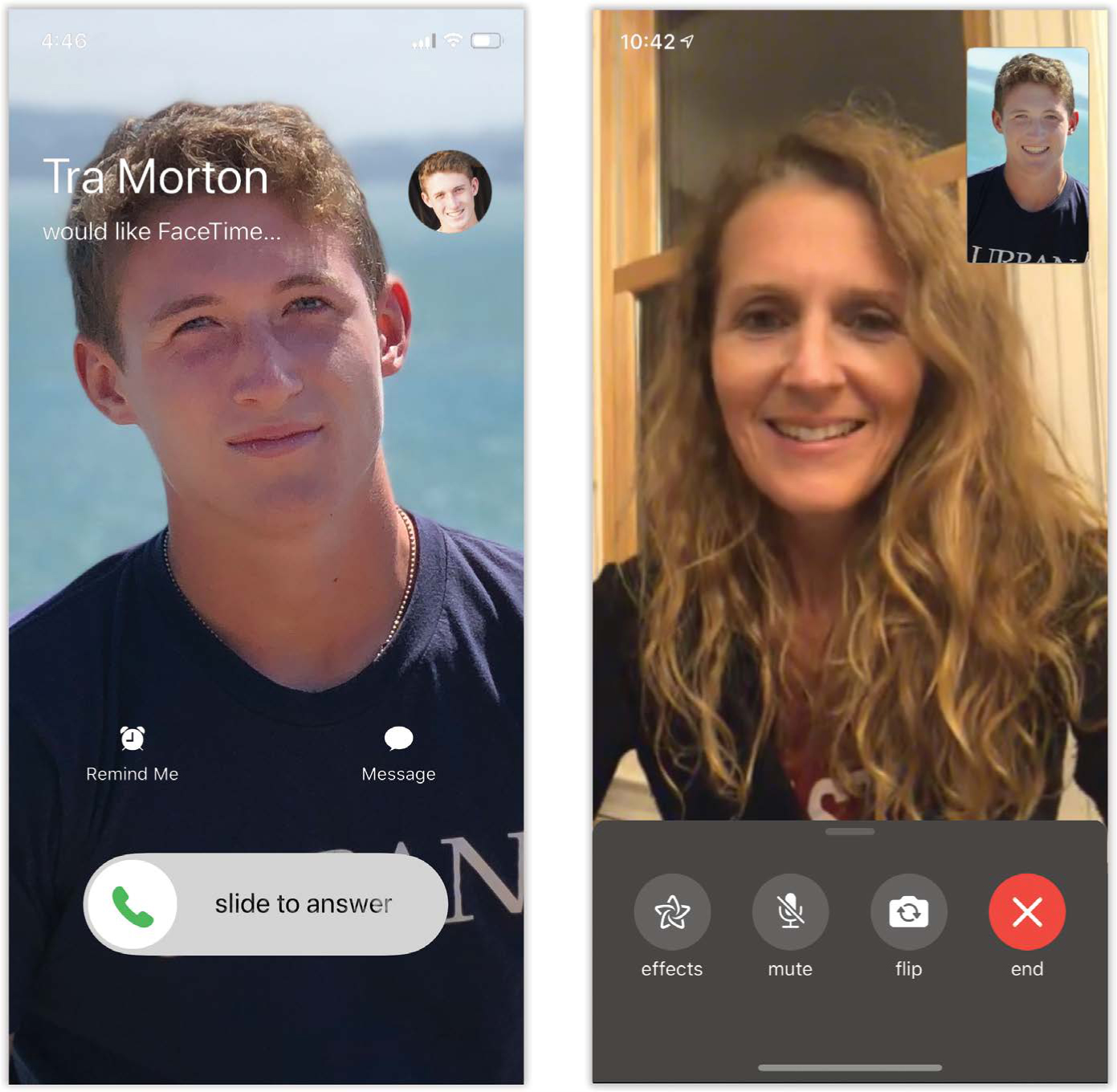
Of course, if you’re not already on a call, the iPhone doesn’t yet know whom you want to call. So you have to tell it. Open the FaceTime app. It presents a list of your recent FaceTime calls. Tap a name to place a new call to that person, or tap
 to view a history of your calls with that person (and buttons for placing new ones).
to view a history of your calls with that person (and buttons for placing new ones).Or, to find your callee from your own Contacts list, tap the
 button. Find a name, tap it, and then tap
button. Find a name, tap it, and then tap  Video to place the call.
Video to place the call.From Contacts. In the Contacts app, if you tap a person’s name, you’ll find a FaceTime button. Or, in the Phone app, call up your Favorites or Recents list. Tap
 next to a name to open the contact’s card; tap FaceTime.
next to a name to open the contact’s card; tap FaceTime.From Messages. If you’re chatting away with somebody by text and you realize that typing is no longer appropriate for the conversation, tap the name or photo at the top of the screen. Tap FaceTime.
At this point, the other guy receives an audio and video message inviting him to a FaceTime call. His screen shows what he looks like, so he can check for spinach in his teeth before accepting your call (facing page, left).
If he taps Accept, you’re on. Your image now fills his screen (facing page, right), and you both see and hear each other in real time. You appear on your own screen, too, in a little inset window, so you can make sure your own lighting looks good.
Once the chat has begun, here’s some of the fun you can have.
Rotate the screen. FaceTime works in either portrait (upright) or landscape (widescreen) view; just turn your phone 90 degrees. Of course, if your calling partner doesn’t also turn her gadget, she’ll see your picture all squished and tiny, with big black areas filling the rest of the screen. (On the Mac, the picture rotates automatically when your partner’s gadget rotates. You don’t have to turn the monitor 90 degrees.)
TIP
The
 (rotation lock) button described in “Customizing the Control Center” works in FaceTime, too. That is, you can stop the picture from rotating when you turn the phone—as long as you’re happy with full-time upright (portrait) orientation.
(rotation lock) button described in “Customizing the Control Center” works in FaceTime, too. That is, you can stop the picture from rotating when you turn the phone—as long as you’re happy with full-time upright (portrait) orientation.Show what’s in front of you. Sometimes you’ll want to show your friend what you’re looking at. That is, you’ll want to turn on the camera on the back of the iPhone, the one pointing away from you, to show off the baby, the artwork, or the broken engine part.
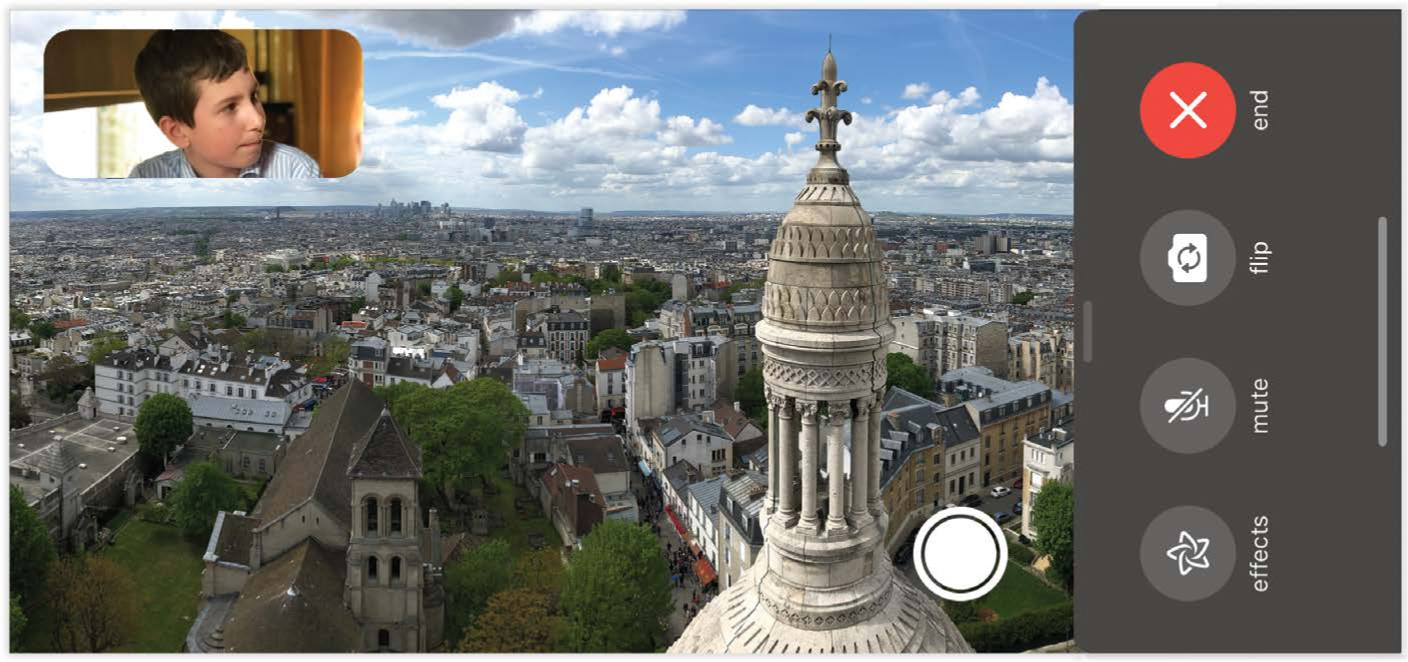
Just tap the screen to make the buttons appear, and then tap flip (
 ). Now you and your callee can both see what you’re seeing. Tap
). Now you and your callee can both see what you’re seeing. Tap  again to return to the front camera.
again to return to the front camera.Snap a commemorative Live Photo. Within a FaceTime call, you can take a Live Photo (“Live Photos”)—three seconds of motion, with sound, deposited into your Photos app.
Tap the screen to make the buttons appear, then tap
 . That button appears only if both you and your pal have turned on FaceTime Live Photos in Settings → FaceTime. A message appears on both screens, so everybody knows what you’ve done and you can’t act creepily.
. That button appears only if both you and your pal have turned on FaceTime Live Photos in Settings → FaceTime. A message appears on both screens, so everybody knows what you’ve done and you can’t act creepily.(Of course, you can also take a plain old screenshot; see “Capturing the Screen”.)
Mute the audio. Tap the screen to make the buttons appear; tap mute
 to silence the audio you’re sending. Great when you need to yell at the kids.
to silence the audio you’re sending. Great when you need to yell at the kids.Mute the video. When you leave the FaceTime app for any reason (open a different app), the other guy’s screen shows just a blurry still photo of your face. He can’t see what you’re doing when you leave the FaceTime screen. He can still hear you, though.
This feature was designed to let you check your calendar, look something up on the web, or whatever, while you’re still chatting. But it’s also a great trick when you need to adjust your clothing, pick at your teeth, or otherwise shield your activity from the person on the other end.
In the meantime, the call is technically still in progress—and a green banner at the top of the Home screens reminds you of that. Tap there, on the green bar, to return to the video call.
You can mute the video even if you’re not leaving the app. Tap the screen to make the buttons appear; swipe up to summon the Options screen, shown below; tap Camera Off. Now you’re just transmitting a blurry photo of yourself.

Change the audio source. Ordinarily, the audio for a FaceTime call comes from your speakerphone, since your pal wouldn’t see much if you were pressing the phone to your ear. But if you swipe upward to view the Options screen, you can use the Speaker button to switch to a different audio source (a Bluetooth headset, a Mac, or whatever you’ve got).
Apply a special effect. If your conversation begins to lag during a FaceTime call, you can always spice things up with one of iOS’s real-time, animated special effects. You can add speech balloons or fireworks around your head; you can substitute a cartoon animal—or cartoon Memoji version of yourself—for your actual head; you can apply an Instagram-type filter; you can slap “stickers” onto yourself; and much more.
Once your FaceTime call is under way, tap the screen to make the buttons appear, and then tap effects (
 ) to reveal the row of available effects buttons. Tap one, dress yourself up, and revel in the admiration (or exasperation) of your video chat partners.
) to reveal the row of available effects buttons. Tap one, dress yourself up, and revel in the admiration (or exasperation) of your video chat partners.
You’re welcome to add more than one of these effects at once. (Animoji and Memoji are available only on Face ID phones.) Many of them, like the text effects, are designed to be used only when the phone is upright (in portrait orientation).
All these effects are described in depth in “Effects”.
Some of the special effects are rather impressive, arresting, and intriguing, at least at first. In practice, though, if you’re over 13, you may find that the novelty wears off quickly.
To turn off all the effects you’ve applied so far, tap the white
 button to turn it off (gray). You now look normal to your callers once again.
button to turn it off (gray). You now look normal to your callers once again.
When you and your buddy have had quite enough video chatting, tap the screen to make the buttons appear, and then tap ![]() to terminate the call. (Although it’s easy to jump from phone call to video chat, there’s no way to go the other direction.)
to terminate the call. (Although it’s easy to jump from phone call to video chat, there’s no way to go the other direction.)
And marvel that you were alive to see the day.
Group FaceTime
Well, it took only eight years. But FaceTime, at last, can connect more than two people at once in a video chat. In fact, it can connect up to 32 people simultaneously, creating a video party line—as long as everyone concerned has iOS 12.1 or later, or macOS Mojave.
Begin the Call
Often, you’ll want to dive into a group video call from within Messages, where a group chat is already under way. To do that, tap the participant-names strip at the top of the window, and then tap FaceTime (below, left). (Or, for a straight-up audio conference call, hit audio.)
Each participant gets a special group FaceTime message, complete with a Join button (below, right). Once you tap it, that special button in Messages changes to show how long the call has been going.
TIP
If you’re in a group Messages session, that Join button remains yours to tap for as long as the group FaceTime call is still going. That is, you don’t have to hop on instantly.
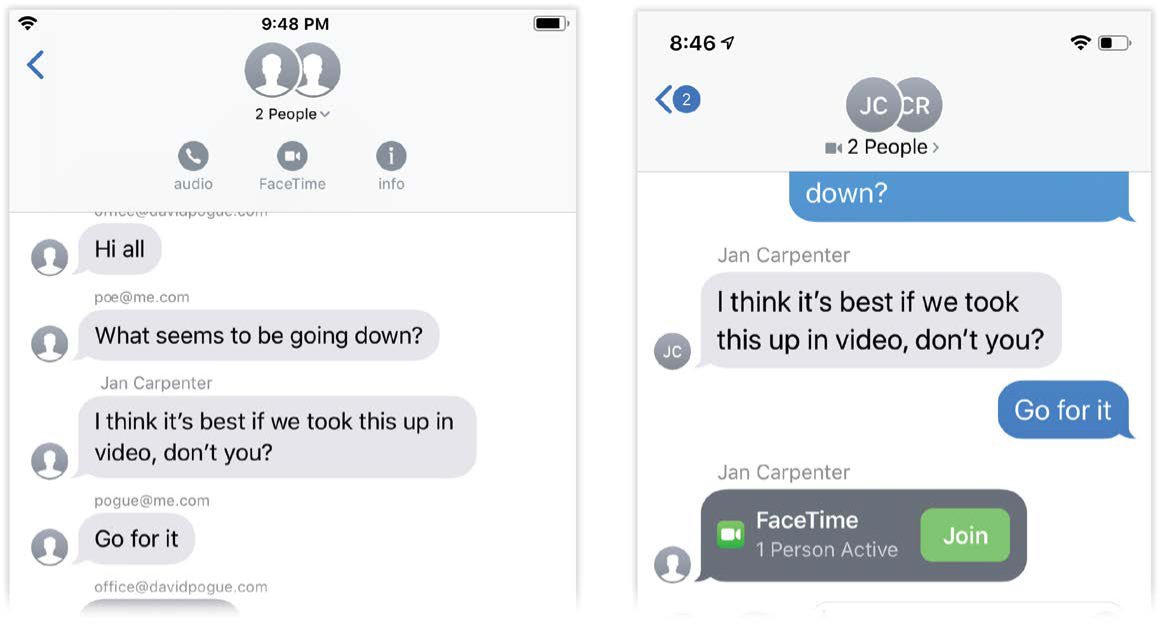
Or you can start in the FaceTime app. Tap the ![]() at top right; in the To box, specify the names of the participants. Then tap Audio or Video.
at top right; in the To box, specify the names of the participants. Then tap Audio or Video.
The other people’s phones start ringing, and when they tap Accept, the audio or video conference begins!
During the Call
In regular FaceTime calls, the other guy’s image fills the screen. How are you supposed to conduct a call with dozens of people?
Each face occupies its own rectangle; the more people joining, the smaller the rectangles get.
When someone is talking, FaceTime brings that person’s rectangle front and center (and makes it bigger) automatically. In a lively conversation, therefore, the four main boxes seem to be constantly inflating and deflating to reflect who’s talking.
But even if someone is not speaking, you can bring him to the front on demand, with either of two degrees of prominence:
Tap his box once. It comes to the front, gets slightly larger, and reveals his name or iCloud ID (below, left).
Double-tap his box. Now it gets much bigger, shamelessly covering up everyone else’s boxes. This is for when you really want to focus on this one person. (Tap again to enshrink the box again.)
TIP
If you’ve tapped once, you can tap the little ![]() icon to zoom that slightly enlarged box into the fully enlarged version.
icon to zoom that slightly enlarged box into the fully enlarged version.
The Roster
The FaceTime app can’t display big rectangles for more than four people at once. Starting with the fifth joiner, a horizontally scrolling row of faces appears at the bottom of the screen—Apple calls it the Roster (below, left). But the idea is the same: If one of them speaks, her box jumps into one of the larger four spots on the screen. And even if she’s not speaking, you can tap or double-tap her square to give it one of the two zoom treatments described already.
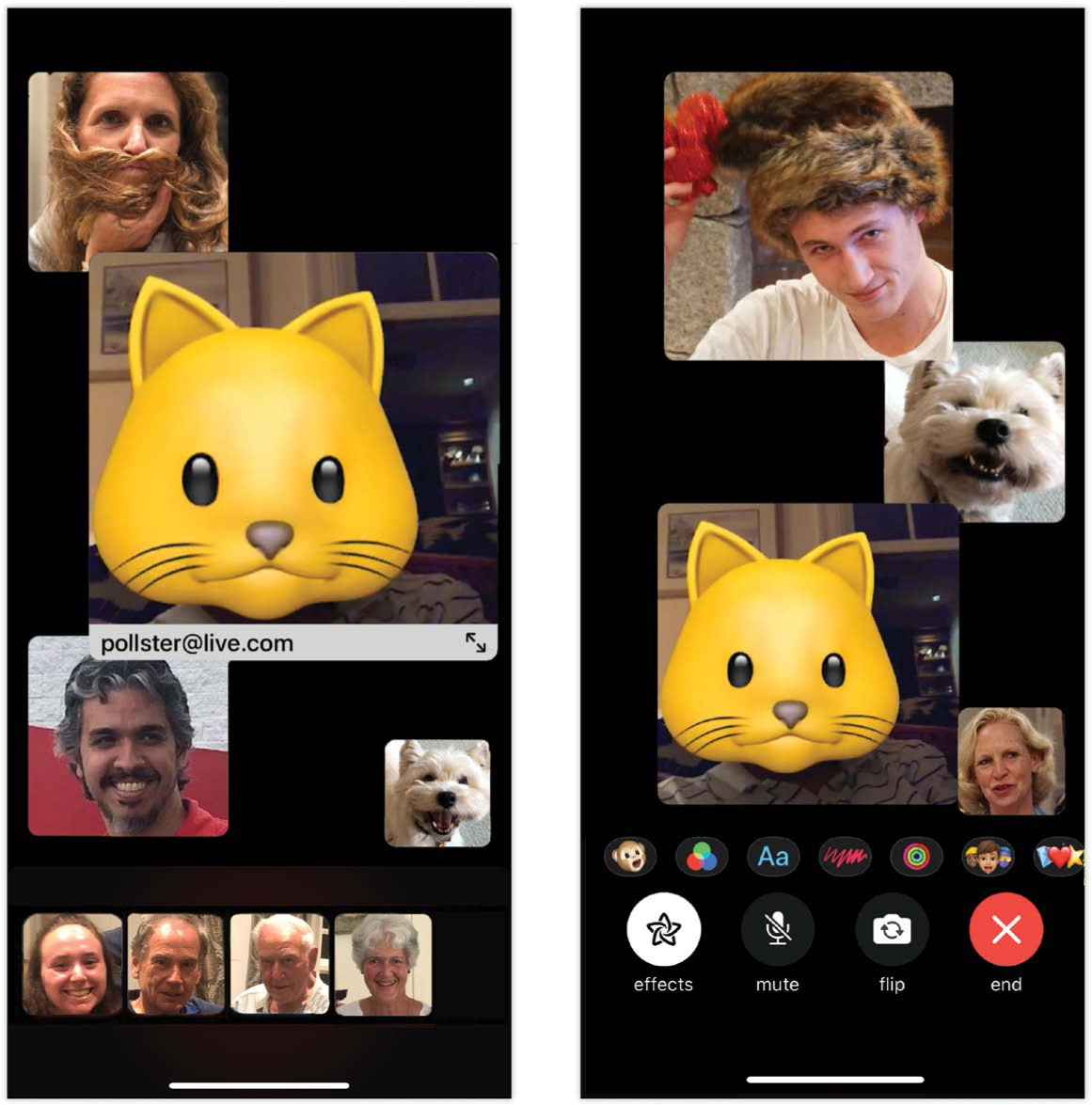
Coming and Going
If someone is inviting you to a group call, a notification lets you know. You’ll see an option called Join, Tap to Join, or ![]() , depending on what you’re doing on the phone. Or, if you’re in Messages in a group chat, you’ll see a Join button.
, depending on what you’re doing on the phone. Or, if you’re in Messages in a group chat, you’ll see a Join button.
If you’d like to add someone to a call that’s underway, tap the screen, tap ![]() , and tap Add Person.
, and tap Add Person.
If someone drops off the call (by tapping ![]() ), everyone else stays on the call, just as with a traditional conference phone call.
), everyone else stays on the call, just as with a traditional conference phone call.
Effects
All the usual FaceTime fun is available during a group FaceTime call. You can flip your camera around, mute your audio or video, apply a sticker or two, add some floating text, or (on a Face ID phone) turn yourself into an Animoji or Memoji (“Apple Pay”).
To see the options, tap the screen once to view the buttons (facing page, right). Then tap ![]() as usual for effects, or drag upward for the Camera Off, Speaker, and Add Person buttons.
as usual for effects, or drag upward for the Camera Off, Speaker, and Add Person buttons.
FaceTime Audio Calls
Video calling is neat and all, but be honest: Don’t you find yourself making phone calls more often? Video calling forces us to be “on,” neatly dressed and well behaved, because we’re on camera. Most of the time, we’re perfectly content (in fact, more content) with audio only.
And FaceTime audio calls don’t eat into your cellphone minutes and aren’t transmitted over your cell carrier’s voice network; instead, these are internet calls. (They use data, not minutes.) When you’re in a Wi-Fi hotspot, they’re free. When you’re not, your carrier’s data network carries your voice.
You start out exactly as you would when making a video call, as described already. That is, you can start from the FaceTime app, the Contacts app, the Phone app, Messages, and so on.
In each spot where FaceTime is available, you get a choice of two types of calls: Video (![]() ) and Audio (
) and Audio (![]() ). (In Messages, if you tap the
). (In Messages, if you tap the ![]() , you get a choice of two voice options: Voice Call and FaceTime Audio. Unless you’re in a group chat, in which case Audio automatically means “group FaceTime audio.”)
, you get a choice of two voice options: Voice Call and FaceTime Audio. Unless you’re in a group chat, in which case Audio automatically means “group FaceTime audio.”)
When you place an audio FaceTime call, the other person’s phone rings exactly as though you’d placed a regular call. All the usual buttons and options are available: Remind Me, Message, Decline, Accept, and so on.
Once you accept the call, it’s just like being on a phone call, too: You have the options Mute, Speaker, FaceTime (that is, “Switch to video”), and Contacts. (What’s missing? The Keypad button and the Merge Calls button. You can’t combine FaceTime audio calls with each other, or with regular cellphone calls. If a cellphone call comes in, you’ll be offered the chance to take it—but you’ll have to hang up on FaceTime.)
You’ll find that the audio quality is amazing—more like FM radio than cellular. It sounds like the other person is right next to your head; you hear every breath, sniff, and sweater rustle.
Try out FaceTime audio calls. Whenever you’re calling another iPhone, iPad, iPod Touch, Mac, or even Apple Watch owner, you’ll save money and minutes by placing these better-sounding free calls.
TIP
iOS even offers FaceTime Call Waiting. If you’re on a FaceTime audio or video call, and someone else FaceTime calls you, your phone rings—and you can either tap Decline or End & Accept.
Bluetooth Accessories
Bluetooth is a short-range cable elimination technology. It’s designed to untether you from equipment that would ordinarily require a cord.
Most people use Bluetooth for two purposes: communicating with a smartwatch or fitness band, or transmitting audio to a wireless speaker, car stereo, or Bluetooth earpiece or headphones.
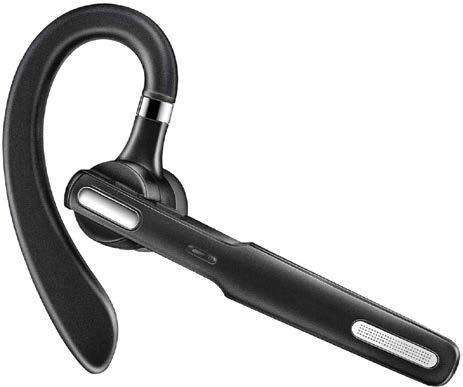
NOTE
See “Returning to a Custom Station” for more on Bluetooth music.
Pairing with a Bluetooth Earpiece or Speaker
Pairing means “marrying” a phone to a Bluetooth accessory so that each works only with the other. If you didn’t do this one-time pairing, then some other guy passing on the sidewalk might hear your conversation through his earpiece. And neither of you would be happy.
The pairing process is different for every cellphone and every Bluetooth earpiece. Usually it involves a sequence like this:
On the earpiece, turn on Bluetooth. Make the earpiece or speaker discoverable.
Discoverable just means that your phone can “see” it. You’ll have to consult the gadget’s instructions to learn how to do so; it’s usually a matter of holding down some button until a light blinks.
On the iPhone, tap Settings → Bluetooth. Turn Bluetooth on.
The iPhone immediately begins searching for nearby Bluetooth equipment. If all goes well, you’ll see the name of your earpiece or speaker show up on the screen.
3. Tap the gadget’s name. Type in the passcode, if necessary.
The passcode is a number, usually four or six digits, that must be typed into the phone within about a minute. You have to enter this only once, during the initial pairing. The idea is to prevent some evildoer sitting nearby in the airport lounge, for example, from secretly pairing his earpiece with your iPhone.
The user’s manual for your earpiece should tell you what the passcode is (if one is even required).
To make calls using a Bluetooth earpiece (or speaker as a speakerphone), you dial using the iPhone itself. You usually use the iPhone’s own volume controls, too. You generally press a button on the earpiece or speaker to answer an incoming call, to swap call-waiting calls, or to end a call.
NOTE
When you’ve got Bluetooth headphones or an earpiece successfully connected, the ![]() symbol appears on your status bar (“Home-Button Phones: The Status Bar”) or, on Face ID phones, on the Control Center. The earpiece’s battery gauge (
symbol appears on your status bar (“Home-Button Phones: The Status Bar”) or, on Face ID phones, on the Control Center. The earpiece’s battery gauge (![]() ) may appear there, too.
) may appear there, too.
If you’re having problems making a particular gadget work, Google it. Type pair Jabra Stealth with iPhone, for example. Chances are good that you’ll find a write-up by somebody who’s successfully worked through the setup.
Bluetooth Car Systems
The iPhone works beautifully with Bluetooth car systems, too. The pairing procedure generally goes exactly as described previously: You make the car discoverable, enter the passcode on the iPhone, and then make the connection.
Once you’re paired up, you can answer an incoming call by pressing a button on your steering wheel, for example. You hear the caller through the car’s speakers, and a microphone for your own voice is hidden in the rearview mirror or dashboard. You make calls either from the iPhone or, in some cars, by dialing the number on the car’s own touchscreen.
Of course, studies show that it’s the act of driving while conversing that causes accidents—not actually holding a cellphone. So the hands-free system is less for safety than for convenience and compliance with laws.
Pairing with a Smartwatch or Fitness Band
The latest Bluetooth technology, called Bluetooth LE (for “low energy”), Bluetooth Smart, or Bluetooth 4.0 (or 5.0), turns on only when necessary and then turns off again to save power. Bluetooth LE has made possible a lot of smartwatches and fitness trackers.
As a handy bonus, you usually do the pairing right in the gadget’s companion app, rather than fumbling around in Settings. That setup makes a lot more sense. For example, when you’re setting up an Apple Watch, you use the Watch app to pair the watch; when you’re setting up a Fitbit, you connect your band wirelessly in the Fitbit app.
Get iPhone: The Missing Manual, 13th Edition now with the O’Reilly learning platform.
O’Reilly members experience books, live events, courses curated by job role, and more from O’Reilly and nearly 200 top publishers.

